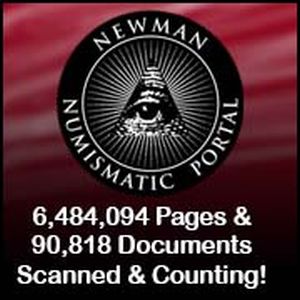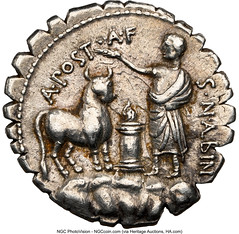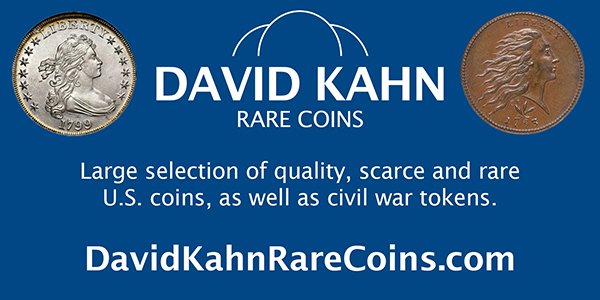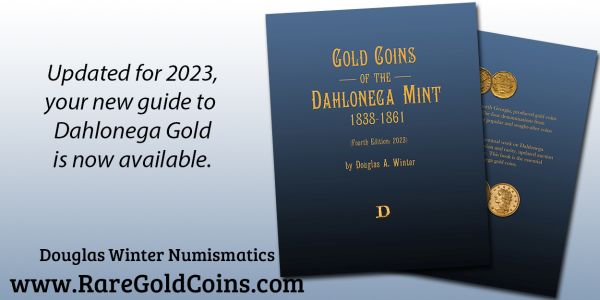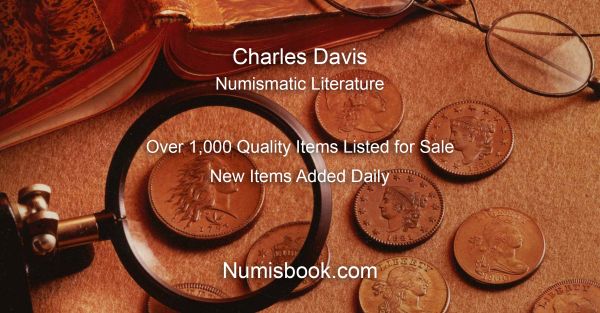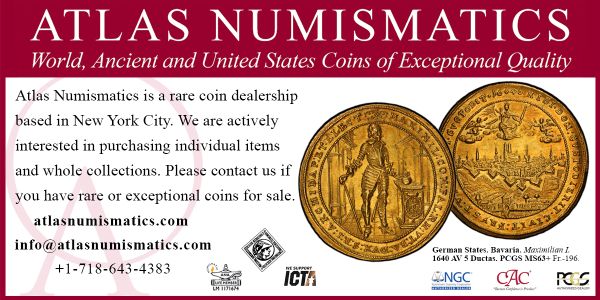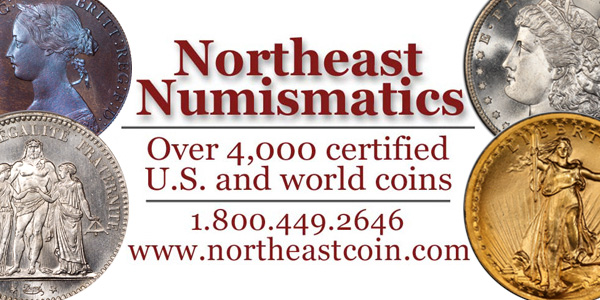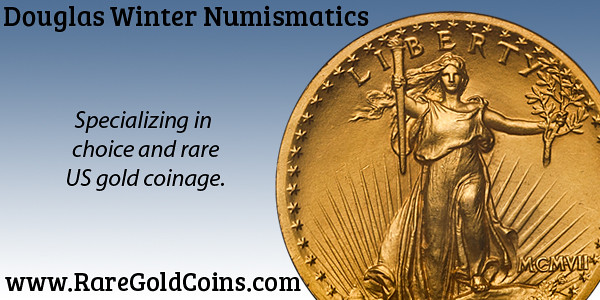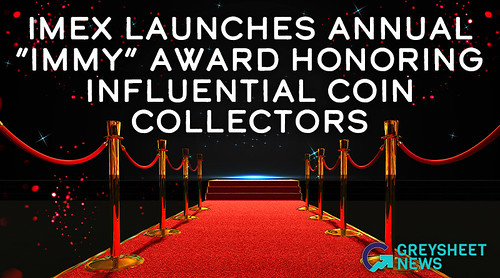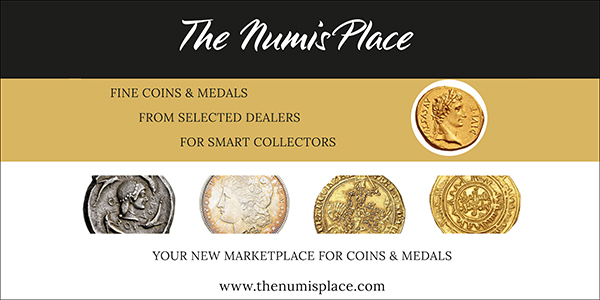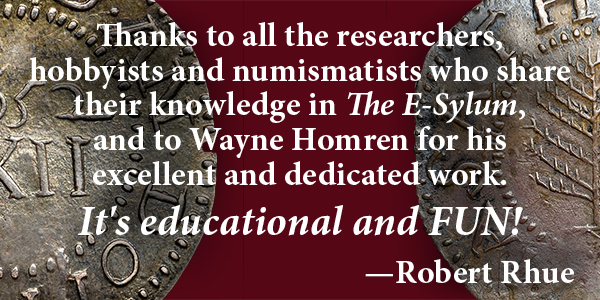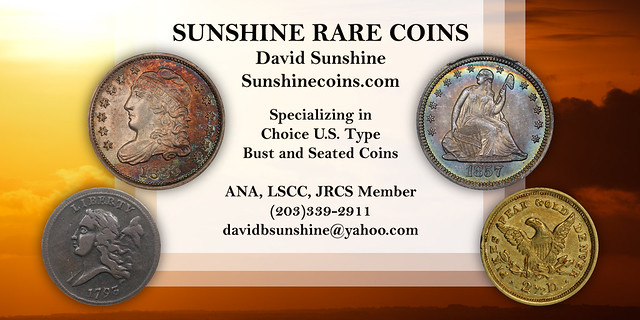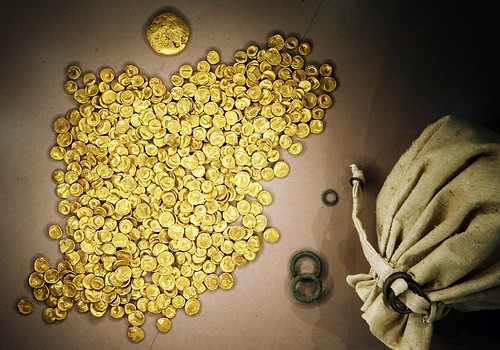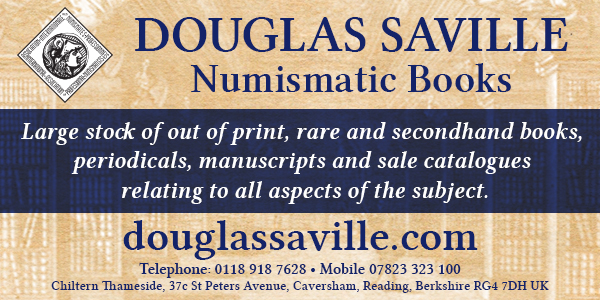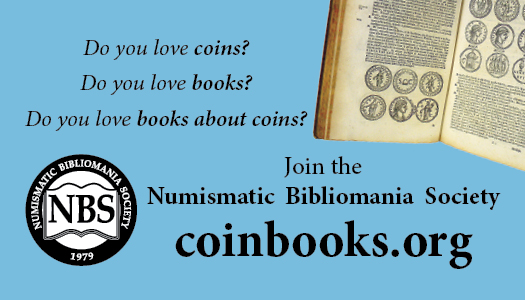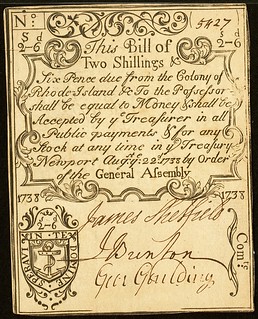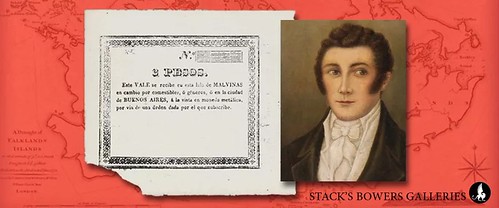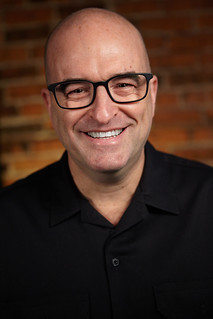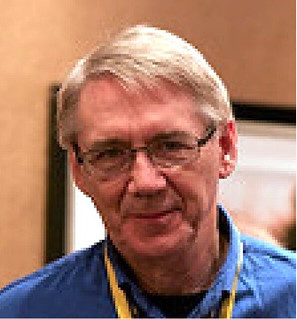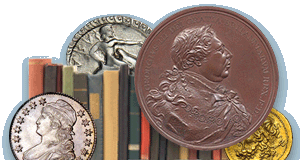
Visit our NBS Sponsors
About UsThe Numismatic Bibliomania Society is a non-profit association devoted to the study and enjoyment of numismatic literature. For more information please see our web site at coinbooks.org SubscriptionsThose wishing to become new E-Sylum subscribers (or wishing to Unsubscribe) can go to the following web page link MembershipThere is a membership application available on the web site Membership Application To join, print the application and return it with your check to the address printed on the application. Print/Digital membership is $40 to addresses in the U.S., and $60 elsewhere. A digital-only membership is available for $25. For those without web access, write to: Jeff Dickerson, Treasurer AsylumFor Asylum mailing address changes and other membership questions, contact Jeff at this email address: treasurer@coinbooks.org SubmissionsTo submit items for publication in The E-Sylum, write to the Editor at this address: whomren@gmail.com BUY THE BOOK BEFORE THE COINSale CalendarWatch here for updates! |
- WAYNE'S WORDS: THE E-SYLUM AUGUST 3, 2025
- 2025 NBS SYMPOSIUM "MENDACIOUS" PRANKSTER REVEAL
- NEW BOOK: GREEK COIN ART
- NEW BOOK: THE KUNINDAS AND THEIR COINS
- NEW BOOK: WAR DOG
- ORIENTAL NUMISMATIC SOCIETY SUMMER 2025
- PAT ALEXANDER (1947-2025)
- WILLIAM EDWARDS METCALF (1947-2025)
- STACK'S BOWERS: Q. DAVID BOWERS TO RETIRE
- PANS EAGLET ADDED TO NEWMAN PORTAL
- VIDEO: THE ENGRAVING PROCESS
- NOTES FROM E-SYLUM READERS: AUGUST 3, 2025
- THE PERKINS PRINTING AND ENGRAVING PLANT
- VOCABULARY TERM: RIM
- IMEX LAUNCHES ANNUAL "IMMY" AWARD
- FRED HOLABIRD ON TOM LEHRER, MUSIC AND LAUGHS
- HERITAGE AUCTIONS: ROMAN REPUBLIC ANCIENT COINS
- STACKS BOWERS: 1836 JUDD-60 GOBRECHT DOLLARS
- CELTIC GOLD HOARD THEFT CONVICTIONS
- THE MIDGARD SERPENT TYPE PENNY
- THE COMMON CENTS ACT
- THE CENT'S MANY USES
- CNG ISSUES 50TH ANNIVERSARY MEDAL
- 1738 RHODE ISLAND RARITY
- 1862 PINETUCKEY GOLD MINES SCRIP NOTE
- ARGENTINE-FALKLAND ISLANDS PAPER MONEY
- LOOSE CHANGE: AUGUST 3, 2025
- ABOUT THIS ISSUE: AUGUST 3, 2025
Content presented in The E-Sylum is not necessarily researched or independently fact-checked, and views expressed do not necessarily represent those of the Numismatic Bibliomania Society.
WAYNE'S WORDS: THE E-SYLUM AUGUST 3, 2025
 New subscribers this week include:
Michael Crowder, courtesy Steve Davis;
Buck Creel, courtesy of Terry Hess;
Rob Tucker, courtesy of Garrett Ziss;
and Paul Hollis.
Welcome aboard! We now have 7,248 subscribers.
New subscribers this week include:
Michael Crowder, courtesy Steve Davis;
Buck Creel, courtesy of Terry Hess;
Rob Tucker, courtesy of Garrett Ziss;
and Paul Hollis.
Welcome aboard! We now have 7,248 subscribers.
Thank you for reading The E-Sylum. If you enjoy it, please send me the email addresses of friends you think may enjoy it as well and I'll send them a subscription. Contact me at whomren@gmail.com anytime regarding your subscription, or questions, comments or suggestions about our content.
Next week we'll attempt to switch over to MailChimp as our email provider. On Monday August 4th, the 27 of you who are already on the MailChimp list should get a second copy of this email. If that experiment works I'll work on moving everyone else over and we'll publish our first full MailChimp issue soon, likely August 10th. Thank you for your patience during this upgrade.
This week we open with a 2025 NBS Symposium topic, three new books, a periodical, two obituaries, a retirement, updates from the Newman Numismatic Portal, and more.
Other topics this week include Greek coin art, Roman Republic coins, the Dickin Medal, Jacob Perkins, auction previews, the Common Cents Act, and paper money from Rhode Island, Pinetucky, and the Falkland Islands.
To learn more about the "Mendacious" prank, the Kunindas and their coins, Judy, the prisoner of war dog, Q. David Bowers, John Mercanti, Holey Dollars, rims, Gobrecht silver dollars, Midgard Serpent pennies, Classical Numismatic Group, and Dealing With Nonsense Online, read on. Have a great week, everyone!
Wayne Homren
Editor, The E-Sylum
2025 NBS SYMPOSIUM "MENDACIOUS" PRANKSTER REVEAL
Numismatic Bibliomania Society President Len Augsburger submitted this announcement of one of the NBS Symposium topics at the upcoming ANA convention in Oklahoma City. -Editor
"Mendacious" Prankster Revealed
 In 1992, American bibliophiles received a one-page flyer in the mail that advertised a numismatic literature sale to be held April 1, 1992 in Fort Worth, TX, at "1204 Magnolia," which just happened to be the former address of the coin dealer B. Max Mehl. The announcement hinted the material was of great value and that the cataloger was not completely familiar with the significance of the items. The circular noted "Many old catalogs in beautiful leathers, though a number marked up with prices and various names."
In 1992, American bibliophiles received a one-page flyer in the mail that advertised a numismatic literature sale to be held April 1, 1992 in Fort Worth, TX, at "1204 Magnolia," which just happened to be the former address of the coin dealer B. Max Mehl. The announcement hinted the material was of great value and that the cataloger was not completely familiar with the significance of the items. The circular noted "Many old catalogs in beautiful leathers, though a number marked up with prices and various names."
Numismatic book collectors, unable to verify specifics in the pre-Internet era, went into a frenzy, with some reputedly booking airfare to the event. Eventually, the ruse was found out, with the key clues being the April Fool's sale date, and the auctioneer's name ("M. N. Daycius"), which represented a phonetic pseudonym – "mendacious," or lying. A "large pile of old coin sales, a few going back to the 1820's" suggested the author was aware of the 1828 Watkins broadside, then thought to be the earliest American numismatic auction sale, a fact known only to those aware of Attinelli's 1876 Numisgraphics bibliography.
Since 1992, the identity of the hoaxster has been the subject of much speculation. Recently, new information has come to light that finally identifies the perpetrator of the "M. N. Daycius Caper." This came to us completely unsolicited, and not in response to any investigation on our part. All shall be revealed at the NBS Symposium at the ANA convention in Oklahoma City, Thursday, August 21, at 1pm.
Link to Martin Nathaniel Daycius sale announcement on Newman Portal:
https://nnp.wustl.edu/library/auctioncompanydetail/515765
NEW BOOK: GREEK COIN ART
Peter Jones has published a new book on Greek Coin Art. Congratulations! Here's his announcement. -Editor
 One day, while attending a coin show in New York City, a dealer recognized me and asked me what I collected. I told him I did not know, but those marvelous 2,000-year-old pieces of silver were masterpieces of ancient sculpture. "Ah!" he said, "Art on coins!" I ended up learning about the fascinating world of ancient Greece, their endemic warfare, their philosophy, and their life.
One day, while attending a coin show in New York City, a dealer recognized me and asked me what I collected. I told him I did not know, but those marvelous 2,000-year-old pieces of silver were masterpieces of ancient sculpture. "Ah!" he said, "Art on coins!" I ended up learning about the fascinating world of ancient Greece, their endemic warfare, their philosophy, and their life.
The book, Greek Coin Art, shows many of the commonest available Greek coins as full page color pictures. The layout is mainly a full page coin photograph on one page with the history behind it on the page opposite. It starts with the "grand tour" (the way collectors classify the different parts of the ancient Greek world), denominations, and pay in ancient times.
Subsequent chapters cover: Non-Greek Europe, Southern Italy and Sicily, Macedonia, Thrace, Thessaly Central Greece and the Peloponnese, Crete, Asia Minor (present-day Turkey), Cyprus and the Levant, The Achaemenids (ancient Persia), The Seleukid Empire, The Parthian Empire, Greco-Baktrians, Indo-Greeks, Ptolemaic Egypt.
The book finishes with a glossary, including a classification of divine beings, a list of gods, allegories and their attributes, mythical animals, weight standards, ancient Greek tribes, and ways to collect Greek coins.
COMMENTS BY ROBERT HOGE, Curator Emeritus, American Numismatic Society
"… A charming tour de force succinctly exploring the entire field of ancient Greek Numismatics. The book contains a glossary of terms and a complete index and bibliography — somewhat unusual in such a handsome volume that many would regard as a kind of "coffee-table book". I firmly believe that anyone having a chance to pass time with this book will come away feeling amply rewarded".
372 pages
148 full-page coin photographs
Hardback 8.5 by 11 inches
Copyright 2025
$89.95 plus postage and packing at BookBaby.com, Amazon, Barnes Noble, etc.
From the Introduction by Robert W. Hoge:
Under the somewhat misleading title of his work, Dr. Peter Jones, with his characteristic British modesty, has hidden what is in reality actually nothing less than a charming tour de force succinctly exploring the entire field of ancient Greek numismatics. While it can indeed be viewed as an examination of artwork from the birthplace of Western civilization — the imagery supplied by Dr. Jones' own exceptionally fine efforts in appropriate photography makes this clear — it is in fact a compendium of the many aspects and by-ways of the field, clearly conveying why the collecting and study of ancient Greek coins has been a popular, fascinating and cherished pastime for hundreds of years.
Greek Coin Art begins with the "Grand Tour" of the field, discussing just what a survey of ancient Greek coinage entails, what is and what is not a part of the scope of the subject matter. In thirteen following chapters, Dr. Jones pursues the coins and the artwork they feature in what, since the eighteenth century, has come to be the standard arrangement of the various series of emissions. Moving circum-Mediterranean from the Hellenic colonies in the West, present day Spain and France, from the Italian "Greater Greece" (Magna Graecia), as the Romans called it, then on into the various regions of the ancient Greek-speaking world, and on to the issues of non-Greek neighbors who shared in the coinage traditions, he examines and explicates many of the most prominent series. And it is these examinations and explications that make this book particularly enjoyable!
Peter Jones is a true polymath! It was my pleasure and honor to first make his acquaintance years ago when, as a student in the American Numismatic Association's Summer Seminar, he took the class that I taught on coinages of the ancient world while I served as curator in charge of the Association's Money Museum. Peter became an outstanding numismatist and collector.
The host of lovely specimens upon which Greek Coin Art is grounded was personally assembled by him; however, his activity did not stop there. Part of the charm and delight to be found in this work lies in the meticulous side-investigations in which his wide-ranging knowledge and curiosity have been brought to bear. Strange features of the relevant religious mythologies and little-known cultural practices are interlaced into the narrative. One will learn about how the ancients actually counted numbers, and where super-fecundation appears in origin stories! As a medical Dr., Peter uses his clinical expertise to expand our understanding of that world in which Greek coin art flourished.
About The Author:
Peter is a life member of ANA, NENA, and USMEXNA, and a member of ANS, IBSS, C4 and MCA, and president of his local coin club, the Mansfield Numismatic Society. He has also authored Notable Notes, Colonial History In Your Hands, Dow Jones by Peter Jones, Commemorative Coin Tales, The First Medals of America, The First Coins of the Americas, TREASURE, Beautiful Banknotes of France, Stock Certificates Art and History, Greek Coin Art, and with Prof. Cynthia Adams, Therapeutic Communication, now in its third edition. A graduate of both Oxford and Cambridge, and an MBA from the University of Connecticut, Peter moved from England with his wife and three daughters to rural Connecticut in 1977, where he practiced internal medicine for 39 years.
I have a copy, and it's a handsome, large pictorial hardcover book. There are great, large color coin photos throughout, but this is no mere coffee-table eye candy book - it's also packed with great information, timelines, history, maps and charts providing a quality one-stop overview of this vast and important field. Peter has studied, organized and encapsulated centuries of history into one large but handy volume. I expect this book to be quite popular with both new and advanced collectors of ancient Greek coins. -Editor
For more information, or to order, see:
https://www.booksoncoins.com/
Greek Coin Art
(https://store.bookbaby.com/book/greek-coin-art1)
NEW BOOK: THE KUNINDAS AND THEIR COINS
In a Facebook post, Manish Verma of the Hinduja Foundation described their recently published book, The Kunindas and their Coins. Thanks to Paula Turner, editor of the Journal of the Oriental Numismatic Society (JONS) for notice of the new book. See the article elsewhere in this issue for more information on the latest JONS issue, which includes a review. -Editor
The Kunindas and their Coins by Shri Devendra Handa.
(Heritage of India Series)
Publisher: Hinduja Foundation
ISBN: 978-81-982180-2-5
Price: 3000/-
 Known from literary sources like the epics, Puranas, classical and specialized texts under various names, the republican Kunindas continued to strike their coins in silver, copper or some alloys in the name of Amoghabhuti. The silver specie based on the module of the Indo-Greek hemi-drachms but purely Indian in form and devices are a visual feast to the eyes. Having purely indigenous types their preference for an alien weight-standard is an interesting feature.
Known from literary sources like the epics, Puranas, classical and specialized texts under various names, the republican Kunindas continued to strike their coins in silver, copper or some alloys in the name of Amoghabhuti. The silver specie based on the module of the Indo-Greek hemi-drachms but purely Indian in form and devices are a visual feast to the eyes. Having purely indigenous types their preference for an alien weight-standard is an interesting feature.
The objects were first discovered by canal diggers near Behat, a location in the Saharanpur district (in modern-day Uttar Pradesh, India) in 1834. These objects are now known from numerous hoards and stray finds, currently in the prized possession of collectors, museums, and institutions.
Hoards refer to large collections of objects that are often buried together, while stray finds refer to items discovered randomly, not in structured archaeological excavations.
The objects were also found throughout the mid-Himalayan regions of Himachal Pradesh and Uttarakhand, in the plains of Punjab, Haryana, Uttar Pradesh, and even Taxila (which is in present-day Pakistan). This wide distribution points to the far-reaching influence and trade networks of the Kuninda people.
In the present work, an effort has been made to explain the significance of various devices and symbols occurring on these coins. There have been controversies regarding the religious proclivity of the Kunindas, but I have tried to establish their faith in Vaishnavism and Vedic rituals. Scholars from Cunningham have attributed the Kunindas copper coins bearing the figure of Chitresvara (Siva) seated on Apasmara-purusha which I have contested and am happy to note that more savants now agree to it. I have offered my arguments against the theory of their confederation with Yaudheya and other tribes as also their alien ethnology, generally believed by most scholars.
I have been studying Kuninda coins for over forty years, and have restudied thousands of coins of the Chakkar, so-called Daruwala and Pandoa hoards besides various other private and institutional holdings.
This work is the first of its kind to systematically analyse and classify the Kuninda coins in a detailed catalogue. Those interested in the economy, production of total volume by the Kuninda coins and die studies may find it quite useful.
Through this series, the Foundation collaborates with leading academics and historians to bring to life our collection in a broader historical context.
To read the complete Facebook post, see:
https://www.linkedin.com/posts/manish-verma-968223341_book-culture-history-activity-7307749517104173056-ECHK/
NEW BOOK: WAR DOG
We often discuss recipients of the Dickin Medal, honoring animals who serve in war. A new children's book tells the incredible story of one of them - Judy, a resourceful Royal Navy dog who saved lives and accompanied crewmembers taken as prisoners of war by Japanese forces. -Editor
 The True Story of Judy, hero of WW2
The True Story of Judy, hero of WW2
My debut picture book is the true story of one dog's incredible bravery, set in the Second World War in the South–East Asian theatre of the Pacific War. After the fall of Singapore, Judy and her crew become prisoners of war.
As the ship's mascot, Judy has many duties. She catches rats, watches out for soldiers who may fall overboard, and she listens out for danger. Judy loves her crew, and they love her.
 She knows that she brings comfort to the men, making her job very important during these hard times. But when her soldiers are taken prisoner and she is separated from her beloved Frank, she must find the strength to keep going. She is their only hope.
She knows that she brings comfort to the men, making her job very important during these hard times. But when her soldiers are taken prisoner and she is separated from her beloved Frank, she must find the strength to keep going. She is their only hope.
This beautiful picture book is a testament to the love and loyalty of dogs and the importance of animal companions.
Judy was awarded the Dickin medal, "For magnificent courage and endurance in Japanese prison camps, which helped to maintain morale among her fellow prisoners, and also for saving many lives through her intelligence and watchfulness."
For more information, or to order, see:
War Dog
(https://tompalmer.co.uk/war-dog/)
I learned about the book from an article in the Mirror. Here's an excerpt. -Editor
The medal citation is simple but powerful: "For magnificent courage and endurance in Japanese Prison Camps... and for saving many lives."
But the honour does not belong to one of the brave troops who battled in the Far East campaign of WWII but to a dog.
 Judy the pointer was the only animal to be officially recognised as a prisoner of war in the conflict, and one of a handful to receive the Dickin Medal, the animal equivalent of the Victoria Cross.
Judy the pointer was the only animal to be officially recognised as a prisoner of war in the conflict, and one of a handful to receive the Dickin Medal, the animal equivalent of the Victoria Cross.
Now, ahead of the 80th commemorations of VJ Day on August 15, her incredible story of capture, survival and courage is being brought to life for the next generation in a new book.
War Dog, by children's author Tom Palmer, charts Judy's astonishing life-saving heroics and stands as testimony to the love and loyalty of our canine companions, even in the most difficult of circumstances.
"There are still stories to be uncovered about the war and Judy's is utterly fascinating," says Tom, a dad-of-one and dog owner from Halifax, West Yorks, who has written more than 60 children's books.
"What she did is unbelievable. It feels almost made-up but it's totally true. There are contemporaneous accounts from former PoWs who were with her in Japan and saw her actions with their own eyes.
"I want the book to show how animals bring hope in difficult times. I also want it to try to explain conflict. War is difficult for children to grasp. But understanding its significance helps them make sense of what's happening today."
To read the complete article, see:
Plucky dog sentenced to death after saving British soldiers' lives in brutal prison camp
(https://www.mirror.co.uk/news/uk-news/plucky-dog-sentenced-death-after-35660554)
ORIENTAL NUMISMATIC SOCIETY SUMMER 2025
The Summer 2025 issue of the Journal of the Oriental Numismatic Society has been published. -Editor
 Journal of the Oriental Numismatic Society
Journal of the Oriental Numismatic Society
260 Summer 2025
Copper coins of Aulikara ruler Yasodharman-Vish?uvardhana
Devendra Handa
Transition from Pahlavi to Kufic: numismatic evidence from Zoroastrian and Muslim governors in the
early Islamic period
Kiarash Gholami
Attribution of coins to the queens of the Utpala dynasty of medieval Kashmir
Gul Rahim Khan
The rebel issue of Giyath al-Din Bahadur Shah (720 H–724 H)
Arup Kumar Saha
Kollam's maritime trade relations with Sri Vijaya: numismatic evidence
Beena Sarasan
ONS News 26
Book review and notice
Editor Paula Turner adds:
"John Deyell has written a full review of Devendra Handa (2025) The Kunindas and Their Coins."
Thanks! See the article elsewhere in this issue for more information on the book. -Editor
For more information, see:
https://www.orientalnumismaticsociety.org/
PAT ALEXANDER (1947-2025)
Earlier this week Secretary-Treasurer John Janeczek passed word that "The New York Numismatic Club is saddened to announce the death of our member Pat Alexander on Monday, July 28, 2025, after a month-long illness. Pat is survived by her husband of 47 years, Past President David Alexander."
E-Sylum Feature Writer and American Numismatic Biographies author Pete Smith submitted this article. Thank you. NOTE: DTA = David Thomason Alexander. Thanks to Len Augsburger, I added a photo from her online obituary, linked below. She died on July 27, 2025. -Editor
 She was born as Patricia Ann LaBranche in Dayton, Ohio, on March 29, 1947. Her parents were
Roge Philip LaBranche (1917-1970) and Delight Aileen Durbin LaBranche (1917-1982). Roge
was a toolmaker and part owner of Dayton Industrial Supply Co.
She was born as Patricia Ann LaBranche in Dayton, Ohio, on March 29, 1947. Her parents were
Roge Philip LaBranche (1917-1970) and Delight Aileen Durbin LaBranche (1917-1982). Roge
was a toolmaker and part owner of Dayton Industrial Supply Co.
Pat graduated from Meadowdale High School in Dayton. She attended Ohio University in Athens and Wright State University in Dayton. She studied Business Administration combined with counseling psychology.
Pat married David Thomason Alexander on December 3, 1977, at Holy Angels Catholic Church in Sidney, Ohio. She was given in marriage by a son from a previous marriage, M. Robert French. Ushers were two guys who worked in the Sidney area, Thomas K. DeLorey and William Tilden Gibbs. Luncheon arrangements were made by Mrs. Marion Russell. She is known in the hobby as Margo.
The newspaper report stated, "Distributed by the couple were 1 1/2 inch aluminum wedding medals, recording date and place on the face of the coin. The reverse bore a quotation from the book of Ruth."
Pat and David were joined by a son in 1980, Christopher Thaddeus Alexander. On September 9, 1986, they were joined by Christina Theresa Alexander.
While David was editor for the Numismatic Literary Guild (NLG) newsletter, Pat was identified as assistant editor.
I have vague recollections from thirty year ago, that Pat was a legal assistant for a New York law firm.
While Pat may not have been a numismatist, she was strongly woven into the social fabric of the hobby. She joined DTA for meetings of the New York Numismatic Club. She participated with DTA in the NLG Bash. She frequently attended the annual ANA conventions.
For the last few years, Pat got around the ANA conventions in a motorized scooter, Eventually, David joined her and they became a two-scooter family.
Pat Alexander's Children
 I could not find evidence of Pat's first marriage. The best evidence of her children appears on a
cent-size Patrick Mint token from about 1977. The obverse legend: "DAVID T. & PATRICIA A.
/ BOBBY / DOUG / (HOMINIDAE) / ALEXANDER / WENDY & / HEATHER / (CANIDAE)
"LA PROVIDENCIA" - SIDNEY, OHIO"
I could not find evidence of Pat's first marriage. The best evidence of her children appears on a
cent-size Patrick Mint token from about 1977. The obverse legend: "DAVID T. & PATRICIA A.
/ BOBBY / DOUG / (HOMINIDAE) / ALEXANDER / WENDY & / HEATHER / (CANIDAE)
"LA PROVIDENCIA" - SIDNEY, OHIO"
Google told me that Hominidae is a great ape and Canidae is a wolf. I find that to be an unflattering description of their children. I suspect the meaning is that Bobby and Doug were human while Wendy and Heather were dogs.
Pat and David issued a series of 1.5 inch aluminum anniversary medals that also make reference to their children. The first has this legend: "DAVID THOMASON / PATRICIA ANN / WED / HOLY ANGELS / CATHOLIC CHURCH / SIDNEY. OHIO / DEC 1977 / A;EXANDER // OUR ANNIVERSARY"
The second anniversary piece has the same obverse. On the reverse is a large A with legends: "DT / PA / 1977- / 1979 / & MRF" I didn't realize until this Friday that the MRF is for M. Robert French. Doug is not mentioned.
The next one has a lot of text: "27 FEBRUARY 1980 / PATRICIA & DAVID / ALEXANDER / & NEW BROTHER ROBERT / ANNOUNCE THE ARRIVAL / OF / CHRISTOPHER THADDEUS / ALEXANDER / BORN / 7 DECEMBER 1979 // PROVIDENTIA / OBSTETRIX / REVIRESCIT" I think this means that Christopher was adopted.
The fourth medal has a counterstamp on remainders of the second medal. It says, "DTA-PAA / 1977 / 1982 / 1979/ CTA" This would be their fifth anniversary medal with CTA representing Christiopher Thaddeus Alexander, A sixth anniversary piece has a "6" counter stamped on the first anniversary piece.
I am not aware of an anniversary medal that mentions Christina Theresa Alexander. She was mentioned in an issue of the NLG Newsletter for Sept-Oct 1986. She was described like a newly minted coin.
This is an example where biographical information may be found on personal medals that is not available through the normal biographical sources.
Indeed. Numismatic evidence is not only a great supplement to archival and printed references, it is sometimes the only resting place of certain information. Many thanks to Pete for a) collecting this material and b) organizing it and using it for research (and sharing it with all of us)! -Editor
To read Pat's online obituary, see:
Pat Maria Alexander
(https://midhudsonnews.com/obituary/pat-maria-alexander/)
WILLIAM EDWARDS METCALF (1947-2025)
American Numismatic Society Executive Director Dr. Ute Wartenberg Kagan submitted this note on the passing of former Chief Curator Bill Metcalf. Sorry to hear this news. -Editor
 It is with great sadness that the American Numismatic Society announces the death of William E. Metcalf, who passed away at the age of 77 on 2 August 2025. Former ANS Chief Curator and one of the most distinguished numismatists in the field of Roman numismatics, he worked at the ANS from 1975 to 2000. In 2024, he received the Society's Archer M. Huntington Award for Excellence in Numismatic Scholarship. His many friends and colleagues at the Society deeply mourn his passing and will cherish his memory with enduring respect and affection. A full obituary detailing his distinguished life and career will appear at a later date.
It is with great sadness that the American Numismatic Society announces the death of William E. Metcalf, who passed away at the age of 77 on 2 August 2025. Former ANS Chief Curator and one of the most distinguished numismatists in the field of Roman numismatics, he worked at the ANS from 1975 to 2000. In 2024, he received the Society's Archer M. Huntington Award for Excellence in Numismatic Scholarship. His many friends and colleagues at the Society deeply mourn his passing and will cherish his memory with enduring respect and affection. A full obituary detailing his distinguished life and career will appear at a later date.
To read the earlier E-Sylum article, see:
METCALF WINS 2024 ANS HUNTINGTON AWARD
(https://www.coinbooks.org/v27/esylum_v27n30a11.html)
STACK'S BOWERS: Q. DAVID BOWERS TO RETIRE
Stack's Bowers announced that after seven decades of research, dealing, and involvement in the numismatic auction industry, Q. David Bowers will be retiring. -Garrett
After over seven decades in the hobby, Stack's Bowers Galleries announces the well-deserved retirement of founder Q. David Bowers. Since the 1950s, numismatics has benefitted immensely from Dave's unsurpassed expertise, deep passion and enthusiastic involvement in the coin hobby. There is not a single collector, dealer or numismatic organization that does not know the name Q. David Bowers, understand the significance of his career, and appreciate his enormous contributions to numismatics. Brian Kendrella, Stack's Bowers Galleries president, stated: "Dave has greatly impacted numismatics over the past seven decades and will continue to do so for many years to come. He has been a wonderful mentor to many of us, and his leadership and guidance have been invaluable. We wish Dave the best in his well-deserved retirement."
Greg Roberts, Stack's Bowers Galleries CEO, said, "Dave has been a colleague and mentor to me for over 40 years. He is a true numismatic genius and friend. I wish him the very best in this next chapter."
Dave became interested in numismatics as a teenager in 1953 collecting Lincoln cents and putting them in a Whitman folder. Soon his interests widened, and he expanded his collection, earning money to pay for it by becoming a "vest pocket dealer" in 1954. The rest is history! In 1955 Dave attended his first American Numismatic Association Convention and issued his first printed catalog with coins illustrated and for sale. This set the trend for hundreds of other publications to come. In 1957 he formed the Rittenhouse Society with others interested in research – Eric P. Newman, Ken Rendell, Dick Johnson, Walter Breen, Ken Bressett, and George Fuld; the society continues with annual meetings today.
"Even though it has been my job for over 70 years, I have truly felt that I have never worked a day in my life. It has given me great joy to have served many clubs and professional organizations and to have written countless books and columns that shared my love for this great pursuit," remarked Dave. "Even for someone who enjoys writing as much as I do and has rarely been at a loss for words, it is difficult to express how much I've loved every minute of it."
In 1964 Dave Bowers published his first book, Coins and Collectors, which became an overnight success and was reprinted, eventually selling tens of thousands of copies nationwide. This set the stage for over 70 books Dave would write, including The History of United States Coinage (for the Johns Hopkins University); Virgil Brand: The Man and His Era; Abe Kosoff: Dean of Numismatics; Louis E. Eliasberg: King of Coins; The Norweb Collection: An American Legacy; the three-volume History of the American Numismatic Association; the two-volume Silver Dollars and Trade Dollars of the United States: A Complete Encyclopedia; Commemorative Coins of the United States: A Complete Encyclopedia; American Coin Treasures and Hoards; Adventures with Rare Coins; More Adventures with Rare Coins; The Treasure Ship S.S. Brother Jonathan; A California Gold Rush History Featuring the Treasure from the S.S. Central America; The Treasure Ship S.S New York; America's Greatest Treasure Ship: The S.S. Central America, The Second Treasure-Finding Journey; the Whitman Encyclopedia of United States Paper Money, a long list of Whitman Publishing Company books (including the Bowers series which focused on numerous collecting specialties), and many more. Along the way Dave won more "Book of the Year" awards given by the Numismatic Literary Guild than has any other author in history.
Dave supervised the handling of many important collections, as well as the research, writing, and production of the catalogs presenting them, again earning more awards and distinctions such as "Catalog of the Year" than has any other. The list of famed collections showcased by Dave and his firms is long and spans his 70+ year career. The Garrett Collection was sold from 1979-1981, while the 1980s also saw sales that included important coins from the Virgil Brand Collection and the collection of Ambassador and Mrs. R. Henry Norweb. In 1982, Dave and his company were chosen to handle the gold portion of the Eliasberg Collection, while sales in 1996 and 1997 featured the copper and silver portions, with the world gold coins were presented in the early 21st century. In a series of sales in the late 1990s Dave's firm brought the Harry W. Bass, Jr. Collection to the market and the 1999 auction of the Childs Collection included an 1804 dollar which sold for over $4 million, a world record price for any coin at the time. Dave has always been passionate about all facets of bringing a collection to market, from numismatic writing and research through marketing and final presentation and even as auctioneer on the podium.
Aside from his successful business ventures, Dave served as president of the Professional Numismatist Guild from 1977 to 1979 and as president of the American Numismatic Association from 1983-1985. He was a numismatic director for Whitman Publications, LLC and the research editor for The Guide Book of United States Coins, the most used price reference in American numismatics. Dave served as selectman for his adopted home town of Wolfeboro, New Hampshire from 2010-2021, and wrote and published three volumes of the History of Wolfeboro.
"I would be remiss if I didn't thank the many friends who made up our staff over the years," commented Dave. "Some have unfortunately passed away, but many are still carrying the numismatic torch at Stack's Bowers Galleries. My hope is that my enthusiasm has been contagious, and they are enjoying this work as much as I did. I am forever grateful for their work ethic, friendship and camaraderie."
Dave can be contacted through the Wolfeboro office by sending a letter to him at SBG, PO Box 1804, Wolfeboro, NH 03894 or by email to ckarstedt@stacksbowers.com or abowers@stacksbowers.com.
Dave's enthusiasm has absolutely been contagious. His writings have inspired and guided multiple generations of collectors, including myself. His Coins and Collectors was one of the books I read soon after becoming a collector, and it opened my eyes to a whole new world of numismatic history and research. My onetime specialties of U.S. merchant counterstamps and encased postage stamps were inspired and informed by his articles and books. His good works are seen throughout the hobby and industry today - an amazing career. Congratulations, and good luck and good health in your retirement. -Editor
PANS EAGLET ADDED TO NEWMAN PORTAL
The latest addition to the Newman Numismatic Portal is the Polish-American Numismatic Society's PANS Eaglet. Project Coordinator Len Augsburger provided the following report. -Editor
PANS Eaglet Added to Newman Portal
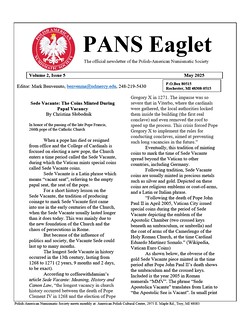 The Polish-American Numismatic Society, established in 1981, is an educational association dedicated to preserving and sharing knowledge pertaining to Polish and United States history and numismatics, world coins, tokens and medals. The group meets monthly in Troy, MI and sponsors two annual shows, in conjunction with the Windsor Coin Club (February) and also with the Huron Valley Numismatic Society (August).
The Polish-American Numismatic Society, established in 1981, is an educational association dedicated to preserving and sharing knowledge pertaining to Polish and United States history and numismatics, world coins, tokens and medals. The group meets monthly in Troy, MI and sponsors two annual shows, in conjunction with the Windsor Coin Club (February) and also with the Huron Valley Numismatic Society (August).
The PANS Eaglet began publication in 2024 and is edited by Mark Benvenuto. Back issues are now archived on Newman Portal. The Eaglet includes coverage of both historical and modern Polish numismatics, in addition to monthly news items. The inaugural issue (July 2024) noted the ANA President's Award, which recognized PANS President Lester Rosik for building bridges between the Polish, Canadian, and American numismatic communities.
Link to Polish-American Numismatic Society home page:
https://pans-club.org/wordpress/
Link to PANS Eaglet on Newman Portal:
https://nnp.wustl.edu/library/publisherdetail/554982
VIDEO: THE ENGRAVING PROCESS
The David Lisot Video Library on the Newman Numismatic Portal can be found at:
https://nnp.wustl.edu/library/multimediadetail/522852
We highlight one of his videos each week in The E-Sylum. Here's one from 2009 with Chief Engraver John Mercanti speaking about New Technology and the Engraving Process. -Editor
 Chief Engraver for the United States Mint John Mercanti discusses new technologies used to create America's coinage. Examples are shown of some of the new commemorative coins being created. You will also see pictures of recently discovered galvanos as well as images of the old mint buildings.
Chief Engraver for the United States Mint John Mercanti discusses new technologies used to create America's coinage. Examples are shown of some of the new commemorative coins being created. You will also see pictures of recently discovered galvanos as well as images of the old mint buildings.
To watch the complete video, see:
New Technology and the Engraving Process
(https://youtu.be/b6QXDHOi3EY)
New Technology and the Engraving Process
(https://nnp.wustl.edu/library/book/549142)
NOTES FROM E-SYLUM READERS: AUGUST 3, 2025
Myron Xenos Services
Steve Davis writes:
 "I went to Ohio yesterday for Myron's memorial service and it was a wonderful tribute, there were many photo boards that showed what a fantastic personality and zest for life he had, times with his family and friends as well as in all his business ventures and in numismatics and numismatic literature. There was a great turnout of friends and family, members of the business, local and the numismatic/literature realm, I saw several out of state plates in the parking lot. This was all a testimony to the lives he touched and the kind of man he was, along with how he treated others.
"I went to Ohio yesterday for Myron's memorial service and it was a wonderful tribute, there were many photo boards that showed what a fantastic personality and zest for life he had, times with his family and friends as well as in all his business ventures and in numismatics and numismatic literature. There was a great turnout of friends and family, members of the business, local and the numismatic/literature realm, I saw several out of state plates in the parking lot. This was all a testimony to the lives he touched and the kind of man he was, along with how he treated others.
"I was fortunate enough to have sat at a table with close friends of his daughter's who related many great tales of Myron as their Softball Coach and the pool parties and vacation times with the Xenos family, according to them Myron was the "Coolest Dad", if you knew Myron at all, you could certainly envision how much fun he must have been in that context. It was a special day for a special guy.
"My heart goes out to Daryl, Stacey and Stefanie and Myron's granddaughter, Taylor; whom he always spoke of and loved bragging about. It was a very tough service and loss for me on a personal level. I have known Myron since I was a kid and he was always such a wonderful guy, made me great deals when he sold me things as a young numismatist, gave me insight, history and then later became a mentor of mine in the auction business, always being a strong bidder, buyer and consignor in virtually every sale I conducted. He recommended many clients to us and we remain forever grateful to him. My wife Lisa and I visited Rocky River many times, had the pleasure of spending time with Myron and Daryl and always looked forward to going to see them.
"Today, August 3, would have been Myron's birthday and Daryl and his daughters had a fantastic Birthday cake at the service luncheon yesterday and we all sang Happy Birthday to him. For those of us in the Great Lakes area and abroad, this will be a loss of such an icon and special person who was wise in both numismatics and numismatic literature - Rest in Peace dear friend…"
Very sad loss. Myron was bigger than life, with an outsize, outgoing personality. Being with him was always fun. He will be missed. -Editor
To read the earlier E-Sylum article, see:
MYRON G. XENOS (1938-2025)
(https://www.coinbooks.org/v28/esylum_v28n30a06.html)
Authors, Books or Libraries on Coins, Etc.
Marie Gibbs writes:
"I was wondering if you have ever come across any information pertaining to collecting currency, tokens or coins that have actual images of authors, books or libraries on them? Appreciate your help!"
Well, I haven't really been tracking that but know there are a number of bookseller tokens picturing books. Perhaps our readers can identify some tokens, medals or banknotes fitting the description. Meanwhile, I'll offer one we pictured a couple weeks ago - George Kolbe's token illustrating a book. -Editor
To read the earlier E-Sylum article, see:
GEORGE FREDERICK KOLBE (1941-2025)
(https://www.coinbooks.org/v28/esylum_v28n29a17.html)
Query: World of the Holey Dollar
I'm interested to know the quantity of copies printed about the following book:
 Book: The World of the Holey Dollar - 1st Edition
Book: The World of the Holey Dollar - 1st Edition
Limited Edition. Privately Printed
Author: Philip Spalding
Year: 1973
Printing Company: Channel Lithograph Co., Santa Barbara, CA
Pages: xvii,(1),252,(1),vi,(1),vii-xii
Size: Small Quarto (8'' x 10 3/4")
Hardcover, Maroon Pictorial Buckram, Gilt
Library of Congress Catalogue Number 73-77615
E.E. Clain-Stefanelli (Battenberg, 1985) #8164
I've tried to find out this information but I have not been successful.
Adrián has compiled a table of prior sales and auction appearances. I wasn't familiar with this one. I reached out to literature dealers Charlie Davis and David Fanning, but neither was aware of the print run. That information is not stated in the book. Can anyone help? -Editor
First Charles III Pound Coin
David Pickup writes:
"I got my first Charles III pound coin yesterday. I have still not had a coin of the new king in my change. This one came from a friend who had another friend who got a bag of them from their bank. King Charles ascended the throne nearly three years ago on 8th September 2022 but hardly anyone has seen coins of the new reign apart from collectors' sets. The reality is cash is not used very much as most payments are online. The main use I have for hard cash now is putting a coin in the slot to get a supermarket trolley. I will not use this one like that. It really is a nice coin with a good portrait, nice lettering and a superb reverse design. Are King Charles coins circulating in the other countries that he is King of such as Australia and Canada?"
To read the earlier E-Sylum article, see:
KING CHARLES III COIN DESIGNS REVEALED
(https://www.coinbooks.org/v25/esylum_v25n40a25.html)
The Scarlett Letter "A" Chopmark
Nancy Hoppe writes:
 I posted the below conversation on my Coin Collecting for Beginners Facebook group. One of the responders suggested I may be dealing with a chopmark and gave me a link to your website. I thought I would share my photos with you to see what you think. I don't feel any impression of the red letter "A" on either side of the banknote and I only see the red "A" on the reverse side when I hold the banknote up to the light. I am also impressed with how well it is positioned next to the star.
I posted the below conversation on my Coin Collecting for Beginners Facebook group. One of the responders suggested I may be dealing with a chopmark and gave me a link to your website. I thought I would share my photos with you to see what you think. I don't feel any impression of the red letter "A" on either side of the banknote and I only see the red "A" on the reverse side when I hold the banknote up to the light. I am also impressed with how well it is positioned next to the star.
Post:
Hi, I have a 2004 A, $50 banknote that I have a question about. The large star has a red letter "A" in the upper right corner. My Google research, indicates that the banknote has passed the design and security features. So, I'm wondering if this is a banknote with an error or if it has been defaced? I am grateful for any help you can give me.
This isn't an error. It seems like a chopmark to me, but not one I have seen before. It's a defaced note, but defaced in an interesting way. Some people collect these, but I've never seen a catalog of them. -Editor
THE PERKINS PRINTING AND ENGRAVING PLANT
Dick Hansom passed along the August 2, 2025 e-Newsletter of the Museum of Old Newberry of Newburyport, Massachusetts with a feature article about the restored Perkins Printing and Engraving building. Thanks! Jacob Perkins cut dies for Massachusetts copper coins and some of the Washington funeral medals. He developed steel engraving plates for paper money, held 40 patents including improvements on the minting process. Here's an excerpt from the article, which goes on to describe the creation of the new Perkins Art & Research Center. -Editor
The Perkins building, tucked in behind and beside the Cushing property, has lived many lives in its 217 years, serving first as the workshop of silversmith, engraver, scientist, and inventor Jacob Perkins. The building was designed for stability and security - paper money was printed here using Perkins' anti-counterfeiting process.
Jacob Perkins moved to London in 1818 and died there in 1849. Back in Newburyport, his shop was used by his brother Abraham and other members of the Perkins family, and then as an industrial building of one kind or another until the 20th century. At one point before 1948, parts of the building and chimney were partially demolished to create a garage front, and five thousand bricks were given to restore the central chimney of the Jackman-Willett House in Newbury.
The Lagoulis family acquired the property in 1973, and in 2006, Jim Lagoulis asked for permission to turn "the vacant and deteriorating building" into apartments. As the oldest generally intact industrial building in Newburyport, preservation-minded people came out to try to save the building from the invasive renovations and alterations that would have been required to turn the building into living space.
In 2007, after a year of negotiations, the building was purchased by the museum with significant support from donors including the Newburyport Bank, and in 2008, the Community Preservation Act helped to fund the initial restoration and stabilization of the building.
These first crucial projects included rebuilding the roof, stabilizing three of the masonry walls, the interior structure, preserving wooden flooring, replacing a staircase and pouring a reinforced cement first floor. Wooden beams and one rusted steel beam were replaced with steel-reinforced wood. Stabilization was completed by May 2010, and the building was officially opened.
In 2017, the Museum of Old Newbury opened its first exhibition in the Perkins Printing and Engraving Plant, Captains and Currency. The exhibit told the personal and professional stories of the Brown and Perkins families in the second floor of the space, while the first and third floors were used for limited storage and programming, but was largely unused.
The museum has now completed a second renovation of the building, adding an archive, library and art storage facility, offloading materials from their main building a few blocks away. -Editor
For more on the Museum of Old Newbury see:
https://www.newburyhistory.org/
To read earlier E-Sylum articles, see:
VISITING JACOB PERKINS' HOMESTEAD
(https://www.coinbooks.org/esylum_v06n23a11.html)
JACOB PERKINS MINT BUILDING THREATENED
(https://www.coinbooks.org/esylum_v07n33a04.html)
IMPENDING SALE OF JACOB PERKINS NEWBURYPORT BUILDING
(https://www.coinbooks.org/esylum_v10n24a21.html)
KARL MOULTON ON THE JACOB PERKINS BUILDING
(https://www.coinbooks.org/esylum_v10n25a20.html)
JACOB PERKINS BUILDING RESTORATION UPDATE
(https://www.coinbooks.org/esylum_v12n51a21.html)
JACOBS PERKINS PRINTING AND ENGRAVING BUILDING OPENED
(https://www.coinbooks.org/esylum_v13n21a28.html)
VOCABULARY TERM: RIM
Here's another entry from Dick Johnson's Encyclopedia of Coin and Medal Terminology. -Editor
Rim. The outermost raised element of a border extending to the edge of a coin or medal. Rims are usually flat, plain and very narrow; however, instead of a flat rim they can be sloped, called oblique; instead of plain they can have raised lines, called reeded rims; and instead of narrow, a rim can have varying width – a simple rim is called a LIP, a wider rim is called a band, the widest rim is called a cartwheel rim (so wide in fact the lettering of the legend is placed incuse on the rim). Some medallic items have no rim at all, often with no other border elements; such items are termed without border.
The purpose of the rim, like that of the border, is manyfold: (1) for a coin the rim is raised to help reduce wear during circulation; (2) the rim and border act as a frame directing the gaze of the viewer inward toward the design; (3) the rim helps form a circular piece and is an extension of upsetting – the preforming of a circular disk into a circular struck piece, and (4) for those high relief pieces that must be trimmed with a trimming tool a rim is required on at least one side (so the piece rests on the rim and not mash any relief).
The rim is often an element of the border, forming the outermost design segment nearest the edge. A rim and a line are the simplest form of border. For more elaborate borders, like molded borders, the rim is the highest plane and other border elements are often formed in steps downward from the rim. See border.
Rims are formed by the outermost surface of a die, and are nearest the restraining collar that forms the edge of the struck piece. In production run coinage, with the use of an upset or preformed blank with a somewhat rounded edge, the metal may not flow into the point where the rim meets the edge. This will cause a tiny bevel at this rim/edge juncture. In more controlled coinage, as proof coinage, with more precisely formed blanks and more exact weight blanks (with exact mass of metal), the precise amount of metal may flow into the point at the rim/edge juncture. This will form an edge with a perfect 90° angle and no bevel whatsoever.
Anomalies of coining at the rim/edge juncture are: (1) too little metal, causing imperfectly formed rims and, more likely, imperfectly formed knurls in the reeding; or (2) too much metal, forming FLASH, where the only place for this metal to go is outward at the juncture of the die and the collar, forming a wire edge or knife edge; and (3) a broken die near its edge, called a rim break, or what a collector would call a cud.
Because of its unique position, rims are most vulnerable to damage. A dropped coin or medal will first damage the rim or edge, thus rim nicks or dents are common. Along with high points, the rims are the first to be closely examined when determining condition. This is true more so for large medals, than with smaller medals or coins, the weight of a heavy medal will acutely damage a rim when dropped. An item without rim nicks is said to have sharp edges.
The rim on a cross of a decoration is called a margin. In Spanish a rim on a coin is called a listel.
To read the complete entry on the Newman Numismatic Portal, see:
Rim
(https://nnp.wustl.edu/library/dictionarydetail/516660)
THE BOOK BAZARRE
IMEX LAUNCHES ANNUAL "IMMY" AWARD
IMEX launches the annual "IMMY" Award, short for "Influence in Money & Memorabilia – Yearly," honoring influential coin collectors. The 2025 recipient is Jack Black. The press release was published last month by Greysheet. -Garrett
The International Money Exposition (IMEX) is proud to announce the launch of a new annual honor in the numismatic community: The IMMY Award — recognizing public figures who have made meaningful contributions to the hobby of coin collecting.
The IMMY (short for Influence in Money & Memorabilia – Yearly) will be presented each year at IMEX to celebrate passion, visibility, and advocacy for numismatics. Much like the Emmy or the Grammy in their respective fields, the IMMY is designed to highlight cultural influence and personal dedication within the world of coins and collectibles.
2023 IMMY Recipient: Buddy Ebsen
Actor Buddy Ebsen, best known for his role as Jed Clampett on The Beverly Hillbillies, is posthumously recognized as the inaugural winner of the IMMY. Ebsen was a dedicated and respected numismatist who assembled one of the most remarkable private collections of American coins, including:
- A complete U.S. Gold Type Set
- A rare 1879 $4 Coiled Hair Stella Pattern
- A pristine set of Panama–Pacific commemorative gold coins
His collection was auctioned in 1987, bringing in over $7.67 million across 3,211 lots — a legacy that continues to inspire collectors to this day.
2025 IMMY Recipient: Jack Black
The 2025 IMMY is awarded to actor and comedian Jack Black, whose lively enthusiasm for coins has brought new energy and visibility to the hobby. On Conan, Black proudly showed off his personal "rare & spicy" collection, which includes:
- A 1793 Flowing Hair Cent
- An unusual Standing Lincoln design
- A bold 1917 Standing Liberty Quarter (pre-chainmail redesign)
Jack Black's playful but genuine love of coin collecting has captured the imagination of a younger generation and helped reinvigorate public interest in numismatics.
Award Presentation – IMEX 2025
Both awards will be formally presented at IMEX 2025, held September 3–6, 2025 at the Music City Center in Nashville, Tennessee. The IMMY ceremony will take place during the show and will feature special guests, collectible showcases, and a celebration of the stories behind these two iconic collectors.
IMEX invites both Jack Black and representatives of the Ebsen family to attend and accept their awards in person. If unavailable, the IMMY awards will be delivered to them along with a commemorative gift from the numismatic community.
For media inquiries, interview requests, or to learn more about the IMMY and IMEX 2025, please visit www.IMEX.show or contact:
Jonathan Lerner
Director of Marketing & Convention
International Money Exposition (IMEX)
Nice idea. We've often discussed celebrity collectors, and this is a great new forum to recognize and perhaps interact with some of them. Fun way to publicize the hobby and reward and encourage their interest. Who will be the first celeb to attend? -Editor
To read the complete article, see:
IMEX Launches Annual "IMMY" Award Honoring Influential Coin Collectors
(https://www.greysheet.com/news/story/imex-launches-annual-immy-award-honoring-influential-coin-collectors)
FRED HOLABIRD ON TOM LEHRER, MUSIC AND LAUGHS
This section of the newsletter is where we usually place biographies. The "IMMY" article before this one in today's issue profiles a couple of celebrity coin collectors. This article is non-numismatic, but includes great life stories from soon-to-retire auctioneer and researcher Fred Holabird, as well as notes about fellow music-playing numismatists Dave Schenkman and Bob Evans. Plus, I'd been itching for an excuse to rave about the work of the late Tom Lehrer, and this essay emailed by Fred to his clients this week fits the bill perfectly. With permission, we're republishing it here. -Editor
An essay by Fred Holabird, July 31, 2025
Tom Lehrer passed away this last week at the great age of 97 years. Those of us "over a certain age" (70) knew of him well, as his music became a part of our lives in the 1960s. I'm not talkin' about rock ‘n roll, I'm talking about humor – a different kind of humor that was certainly appreciated by a bunch of nerdy science-math kids like us in high school and college. Rolling Stone magazine called it a "Cult Following", but I don't agree. It is plain old, good fun humor.
Not everybody has heard of Lehrer. He was a mainstay on an old radio show we got in southern California called "Dr. Demento", put on by Barret Eugene Hanson, which ran for over fifty years. My guess is that it was syndicated all over America, but I never checked. All I ever knew was that we got it, and we were glued to it, on every Friday night, as I recall.
My best friend in high school was Monte Ragland, one of our semi-nerdy group, except that he and I were the athletes. He is one of those special friends you think about every day, and never get to talk to enough as you get older. Our "group" had what later became a really impressive group of professionals – physicist, biochemist, geologist… Monte stayed local at Cal Tech, while I went as far away as possible to Humboldt State. For years my Mom complained bitterly that I didn't go to Cal Tech. Heck, she'd have had me running her errands all day, every day, and I would never have learned anything. The other guys went to Berkeley and UC San Diego.
Monte and I developed an affinity for Lehrer's songs. They made fun of pretty much everything – political, social, religion, music, science, math. You name it, he hammered out something wonderful on the piano with his outrageous lyrics. Lehrer was a math grad student at Harvard when he started. My friend John Schilling, the Director of the Nevada Bureau of Mines for 17 years, was a geology student at Harvard when Lehrer played at the Rathskeller there. When John found out I had two albums of Lehrer's when we met in the mid 1970s, we were off to the races with stories. He attended many of Lehrer's small sessions at Harvard, and had the same two albums as me. Schilling told me that Harvard thought Lehrer was getting distracted by his music, and was told to do one or the other – Math or music. While Schilling said, "so Lehrer simply moved over to MIT and did both," I never found out if that was true or not, but it certainly makes the story more humorous.
At Humboldt, my ability to write improved. I had always been a fan of literature and history. In high school, about the mid 1960s, they started these new classes called "Advanced Placement." None of us really knew what they were, but we got put in the few that existed. A bunch of us took the "AP" exams and did well, but it was a whole new thing for the colleges and universities, because they didn't know what to do with us at that level. We were among the first. So the university administrators skipped us out of all the basic lower division general college classes that everybody else had to take. I took every geology class that was offered while I was there. I loved literature, so I took an advanced lit course with a fantastic professor. He helped teach us about better interpretational writing skills. So… you guessed it … I wrote an essay on Lehrer's songs. I got an "F".
Huh? I immediately complained. He said it had to be a copy of a published paper, and therefore an "F." I told him it came from me, …every word, every sentence, every thought. He said "prove it", so I immediately invited him over for dinner that very night at 5pm, and he came. I put on those two albums, and the evening switched to a two hour discussion of Lehrer's work (circa 1971-2) with lots of laughter and fun. Needless to say, he changed my grade to an "A."
Fast forward to today. Well… almost.
Back then I played the guitar. I learned in the style of Lightfoot, Denver and Fogerty (all the same or very similar finger picking patterns). There was a couple of us that played at our geology summer field camp in the Inyo mountains and everybody enjoyed the songs and sing along. Along the way, somehow I found a Lehrer songbook, played a few such as "Poisoning the Pigeons in the Park" and other satirical wonderments during my "courtship" with Robin. But over time, life and work got in the way, and the guitar went into the closet … for the next … 37 years.
Then ten years ago, out it came. It won't go back. "Mr. Martin", my Martin guitar, is too important. Now I have five 6" notebooks full of my regular songs. Doesn't everybody have at least 1000 songs they play? I think so. I've been fortunate enough to play with at least half a dozen groups and do a lot of single or "stand up" performances at saloons, wine bars, and whoever asks nicely, (and even a song following several technical geology lectures. After all, you've got to raise the bar somehow!)
During performances, I always try to include at least one Tom Lehrer song, and they are always a big hit, especially for those that haven't heard any of them before. One of my favorite stories was playing "Masochism Tango" for a group of doctors and lawyers. Lehrer's words and music had this group in stitches, laughing for at least ten minutes afterward. Later, down the road, every time a particular doctor was in the audience, he'd always ask for that song. This year, I was fortunate enough to be asked to play at another "gig" that he attended, but this time, his health was poor. I'll never forget the smile and joy on his face the whole time. He died just a week later.
I ache for the touch of your lips dear,
But much more for the touch of your whips dear
You can raise welts, like nobody else
As we dance to the Masochism Tango …
Music has an impact on people's lives. Some don't like it at all – any of it. Others are listening constantly, or at least have it in the background. For goofballs like myself and great friends and musicians Bob Evans and Dave Schenkman, music is in our blood. Its not our main occupation by any means, but when Bob and I are together these days, out come the instruments. (If Dave lived out here, we'd be big trouble.) And out come the Tom Lehrer songs. Now and then I'll do a medley of an old folk song and run it right into a Lehrer song, dropping unadulterated humor right into a soft lullaby of a folk song, … and then its too late, "I've gotcha," and the audience goes crazy. I did that a few times with the Token and Medal guys- specifically Jeff's So-Called Dollar group. Pure fun!
Music and laughter go hand in hand. A smile generates warmth. Smiles and laughter generate a special feeling that takes us all away from the realities and tasks of life, if even for a few minutes. If laughter is a "cult," (it's not) I want in!
Thanks Tom Lehrer for the decades of smiles and laughter you've brought us, and in so doing, for making the world a happier place. So while you are perusing our auction lots, google up some Tom Lehrer songs and have some fun. Don't miss "Vatican Rag" or "Poisoning the Pigeons in the Park", just to name a few. But I won't give away some of my other favorites. I'm going to drop them on you like an atom bomb when you least expect it.
If you'd like to learn more about Tom Lehrer and his life, see the wonderful essay just written by Matt Zoller Seitz at Rogerebert.com. I can tell this guy has Lehrer in his blood too.
Dr. Demento was indeed syndicated nationwide, and I became a big fan in Pittsburgh. I bought and continually played three Tom Lehrer albums. The man was a musical and lyrical genius, and his songs tore politics and popular culture to shreds. Although some topics are dated now, the themes are timeless. -Editor
His song "National Brotherhood Week" was a send-up of platitudes about racial conciliation during bloody civil rights encounters and famously envisioned Black singer and civil rights activist Lena Horne and segregationist Alabama sheriff James Clark dancing cheek to cheek.
Thomas Andrew Lehrer was born April 9, 1928, in Manhattan, where his father was a necktie manufacturer. He described himself as "Jewish by ancestry — more to do with the delicatessen than the synagogue."
He began studying classical piano at 7 but soon abandoned it in favor of learning the popular songs of the day. He frequently credited his parents with introducing him to musical theater as a child.
After graduating from the Loomis Chaffee prep school in Connecticut, Mr. Lehrer was admitted to Harvard University in 1943 at age 14. He had written his admissions essay in rhyming verse.
He studied mathematics, completing a bachelor's degree in 1946 and a master's degree the following year.
In 1950, he began singing his humorous songs at university parties and functions. Three years later, having realized with some surprise that he had accumulated enough material to make a record, he paid $15 for an hour of studio time and recorded the dozen tunes that comprise "Songs by Tom Lehrer" in one sitting.
He had 400 copies pressed, which he sold on the Harvard campus for $3 each. Mr. Lehrer had taken care to make only as many copies as he thought he could sell without losing money, but he soon began to get mail orders from across the country. The record — whose alternately prurient and macabre lyrics precluded radio airplay in the United States — gained momentum by word of mouth. He made his first nightclub appearance — at the Blue Angel in New York — the same year.
Mr. Lehrer's nonacademic jobs were few but colorful — and proved to be excellent songwriting fodder. In the summer of 1952, he worked at Los Alamos for the Atomic Energy Commission, and he was employed as a theoretical physicist for Baird Atomic the following year. Rather than wait to be drafted, he enlisted in the Army (inspiration for his tune "It Makes a Fellow Proud to be a Soldier") and worked for the National Security Agency from 1955 to 1957.
To read the complete article, see:
Tom Lehrer, master satirist of Cold War era, dies at 97
(https://www.washingtonpost.com/obituaries/2025/07/27/tom-lehrer-satire-music-dies/)
His last sustained burst of songwriting came in 1971, when he contributed "Silent E" and other educational ditties to the PBS children's series "The Electric Company."
By 1981 he had fallen so far off the cultural radar that, he told The Harvard Crimson, some people thought he was dead. ("I was hoping the rumors would cut down on the junk mail," he said.)
A new generation was introduced to the Lehrer songbook in 1980 when the British impresario Cameron Mackintosh presented "Tomfoolery," a revue of his songs, in London. The show was a hit there and was later produced in New York, Washington, Dublin and elsewhere.
With characteristic self-deprecation, Mr. Lehrer attributed the show's success to a shortage of new songwriters. "It was inevitable," he said, "that someone would peer into the almost empty barrel and notice me down there."
When "Tomfoolery" played at the Village Gate in New York in 1981, Mr. Lehrer explained to The Times why he had stopped writing. "The Vietnam War is what changed it," he said. "Everybody got earnest. My purpose was to make people laugh and not applaud. If the audience applauds, they're just showing they agree with me." On another occasion he famously offered another explanation: "Political satire became obsolete when Henry Kissinger was awarded the Nobel Peace Prize."
To read the complete article, see:
Tom Lehrer, Musical Satirist With a Dark Streak, Dies at 97
(https://www.nytimes.com/2025/07/27/arts/music/tom-lehrer-dead.html)
Notably, Lehrer outlived his New York Times obituary writer, who passed away in 2023. Long live Tom Lehrer! Words to live by: "Life is like a sewer - what you get out of it depends on what you put into it."
QUICK QUIZ: Who once gave a numismatic talk entirely in rhyming verse ala Tom Lehrer? -Editor
See also:
Life is Like a Piano: Tom Lehrer (1928-2025)
(https://www.rogerebert.com/tributes/life-is-like-a-piano-tom-lehrer-1928-2005)
HERITAGE AUCTIONS: ROMAN REPUBLIC ANCIENT COINS
Heritage Auctions will be hosting their Roman Republic Ancient Coins Showcase Auction on August 3. Select items are discussed below. -Garrett
P. Licinius Crassus M.f. (ca. 55 BC). AR denarius (18mm, 4.03 gm, 8h). NGC Choice XF 5/5 - 4/5. Rome. S•C, laureate, draped bust of Venus right, seen from front, wearing stephane, pendant earring and beaded necklace, hair in large chignon at back of head / P•CRASSVS•-M•F, female figure, in military attire, standing facing, head right, right hand grasping bridle of horse standing left behind her with right foreleg raised, grounded spear in left hand; cuirass at feet to left, shield at feet to right. Crawford 430/1. Sydenham 929. Licinia 18. Beautiful iridescent toning.
To read the complete item description, see:
P. Licinius Crassus M.f. (ca. 55 BC). AR denarius (18mm, 4.03 gm, 8h). NGC Choice XF 5/5 - 4/5.
(https://coins.ha.com/itm/ancients/roman-republic/roman-republic-p-licinius-crassus-mf-ca-55-bc-ar-denarius-18mm-403-gm-8h-ngc-choice-xf-5-5-4-5/a/61534-25124.s)
A. Postumius A.f. Sp.n. Albinus (ca. 81 BC). AR serratus denarius (19mm, 4.02 gm, 2h). NGC XF 5/5 - 4/5. Rome. Draped bust of Diana right, hair tied in topknot, bow and quiver over shoulder; bucranium above head / A•POST•A•F•-S•N•ALBIN (AL ligate), togate figure standing facing, head left, on rock platform, with aspergillum in outstretched right hand, over bull standing right; lit altar between them. Crawford 372/1. Sydenham 745.
To read the complete item description, see:
A. Postumius A.f. Sp.n. Albinus (ca. 81 BC). AR serratus denarius (19mm, 4.02 gm, 2h). NGC XF 5/5 - 4/5.
(https://coins.ha.com/itm/ancients/roman-republic/roman-republic-a-postumius-af-spn-albinus-ca-81-bc-ar-serratus-denarius-19mm-402-gm-2h-ngc-xf-5-5-4-/a/61534-25087.s)
Augustus (27 BC-AD 14). AR denarius (19mm, 3.79 gm, 1h). NGC Choice VF 5/5 - 3/5. Pergamum, ca. 27 BC. CAESAR, bare head of Augustus right; dotted border / AVGVSTVS, bull standing right, head raised; dotted border. RIC I 475. Pretty azure toning.
Born on 23 September 63 BC into a wealthy plebeian family, Augustus, originally Gaius Octavius, was the grandnephew and posthumously adopted son of Julius Caesar. This inheritance set him on a collision course with Rome's political elite, leading to the formation of the Second Triumvirate with Marc Antony and Marcus Aemilius Lepidus. Their initial unity against Caesar's assassins eventually gave way to conflict, from which Augustus emerged as Rome's first true emperor after victories in key battles like Philippi and Actium. In 27 BC, he was honored with the title "Augustus" by the Senate, signaling the start of his reign and the Pax Romana, a golden era of peace, prosperity, and cultural flourishing that lasted over two centuries.
Augustus' rule saw significant military, administrative, and cultural reforms that stabilized and enriched the empire. He established a standing army, including the Praetorian Guard, reorganized Rome's provinces, and became a patron of the arts, fostering the careers of poets like Virgil and Horace and commissioning monumental buildings that reshaped Rome. His savvy use of coinage to communicate his achievements and vision helped solidify his power and legacy. Augustus died in AD 14, he left behind a transformed Rome. Through Suetonius's "The Twelve Caesars" and his own "Res Gestae Divi Augusti," we glimpse the life and achievements of a ruler who balanced autocracy with republican ideals, setting a precedent for future emperors and leaving an indelible mark on Roman history.
To read the complete item description, see:
Augustus (27 BC-AD 14). AR denarius (19mm, 3.79 gm, 1h). NGC Choice VF 5/5 - 3/5.
(https://coins.ha.com/itm/ancients/roman-imperial/roman-imperial-augustus-27-bc-ad-14-ar-denarius-19mm-379-gm-1h-ngc-choice-vf-5-5-3-5/a/61534-25226.s)
L. Cestius and C. Norbanus (ca. 43 BC). AV aureus (20mm, 8.05 gm, 12h). NGC AU 5/5 - 1/5, damage. Rome, ca. January-April 43 BC. Draped bust of Africa right, seen from front, wearing elephant skin headdress over helmet; large dotted border / L•CESTIVS / C•NORBA, Corinthian helmet right on curule chair, legs decorated with eagles flying right; S•C-P R in fields, dotted border. Calicó 3. Crawford 491/1a. Sydenham 1153. Cestia 1 and Norbana 3.
This intriguing gold aureus belongs to the 12 months immediately following the assassination of Julius Caesar, which produced a chaotic situation in Rome when the Senate briefly regained its preeminence and a host of unlikely alliances were formed and broken up. Octavian, Caesar's young heir, allied himself with Cicero and the Senate against Marc Antony, who, following the end of his Consulship on 1 January 43 BC, took an army north to attack Decimus Albinus Brutus, one of the assassins, who had been appointed by the Senate as governor of Cisalpine Gaul. The new Consuls Hirtius and Pansa, in turn, raised a Senatorial army and set off to attack Antony, ostensibly with Octavian's support. Lucius Cestius and Gaius Norbanus, both Caesarians and supporters of Octavian, were elected Praetors for 43 BC and ordered the striking of this issue of gold aurei to pay the Senatorial soldiers. Two of the new legions were raised in Africa, reflected by the personification on the obverse of this piece. The curule chair on the reverse reflects the authority of the Consuls and Praetors. The alliance between Octavian and Senate would prove to be short-lived, and the latter's renewed authority was swept away when Octavian, Antony, and Lepidus formed the Second Triumvirate.
To read the complete item description, see:
L. Cestius and C. Norbanus (ca. 43 BC). AV aureus (20mm, 8.05 gm, 12h). NGC AU 5/5 - 1/5, damage.
(https://coins.ha.com/itm/ancients/roman-republic/roman-republic-l-cestius-and-c-norbanus-ca-43-bc-av-aureus-20mm-805-gm-12h-ngc-au-5-5-1-5-damage/a/61534-25178.s)
L. Calpurnius Piso Frugi (ca. 90 BC). AR denarius (18mm. 3.98 gm, 1h). NGC Choice XF 5/5 - 5/5. Rome. Laureate head of Apollo right; L behind, L before / L•PISO FRVGI / ?XXIII (III barred), horseman galloping right, palm branch over shoulder in left hand, reins in right. Crawford 340/1. Cf. RRSC D136.1c for similar control number on reverse. Stone blue backlight on obverse, iridescent toning on reverse.
To read the complete item description, see:
L. Calpurnius Piso Frugi (ca. 90 BC). AR denarius (18mm. 3.98 gm, 1h). NGC Choice XF 5/5 - 5/5.
(https://coins.ha.com/itm/ancients/roman-republic/roman-republic-l-calpurnius-piso-frugi-ca-90-bc-ar-denarius-18mm-398-gm-1h-ngc-choice-xf-5-5-5-5/a/61534-25066.s)
L. Cornelius Cinna (ca. 169-158 BC). AE as (30mm, 2h). NGC Choice Fine. Rome. Laureate head of Janus; I (mark of value) above / CINA, prow of war galley right; I (mark of value) in right field, ROMA below. Crawford 178/1. Sydenham 368. Cornelia 11.
From the Sulla Collection.
To read the complete item description, see:
L. Cornelius Cinna (ca. 169-158 BC). AE as (30mm, 2h). NGC Choice Fine.
(https://coins.ha.com/itm/ancients/roman-republic/roman-republic-l-cornelius-cinna-ca-169-158-bc-ae-as-30mm-2h-ngc-choice-fine/a/61534-25011.s)
STACKS BOWERS: 1836 JUDD-60 GOBRECHT DOLLARS
Stack's Bowers Senior Numismatist Greg Cohen published this article about 1836 Judd-60 Gobrecht Dollars in the firm's United States Coin of the Week column. -Garrett
Few issues in the canon of American coins are as confusing as the Gobrecht silver dollars of 1836, 1838, and 1839. Originally cataloged by J. Hewitt Judd as patterns, more recent scholarship has determined that at least 1,000 pieces of Judd-60 were struck for circulation in December 1836. Today, numismatic scholars recognize four different die alignments for Gobrecht dollars, designated as I (coin turn, eagle flying upwards), II (medal turn, eagle flying upwards), III (coin turn, eagle flying level with respect to obverse), and IV (medal turn, eagle flying level with respect to obverse). When Walter Breen wrote his Complete Encyclopedia in 1988, he considered Die Alignment I examples of the Judd-60 Name on Base issue to be originals from 1836 and Die Alignment II pieces to be from a mintage of 600 pieces delivered in March of 1837. He regarded Die Alignment III and IV pieces as restrikes.
This view had been challenged by the early 1990s, when it was found that many Die Alignment IV pieces evinced signs of circulation, suggesting that they had been made for that purpose and not to accommodate coin collectors. Modern research by Craig Sholley, John Dannreuther, and Saul Teichman (based on an exhaustive examination of die state evidence), reported that the die alignment sequence of Judd-60 Gobrecht dollars is actually I-IV-II-IV-I-IV. All examples in these alignments are originals attributed to the December 1836 issue of 1,000 coins; the 600 pieces struck in March 1837 represent a test striking, and all were subsequently melted. Die alignment III pieces are still regarded as restrikes coined decades later than 1836. Andrew Pollock in his United States Patterns and Related Issues considered Die Alignment II and III pieces as the scarcest alignment varieties, followed by IV. He regarded Die Alignment I pieces to be the most readily available.
Our Global Showcase Auction features Gobrecht dollars from the ANS Collection (which were once a part of the Dr. Julius Korein Collection, and are being sold for the benefit of the American Numismatic Society). Included are examples of each of the three Die Alignments attributed to the original 1,000-coin mintage of December 1836.


The Die Alignment I coin is graded Proof-62 by PCGS and has a CMQ approval sticker. A lovely and nearly choice example that is a wonderful example for this type.


The Die Alignment II coin is graded Proof-58 by PCGS and has a CMQ sticker. This piece has just some light rub and a few light scratches that keep it from an Uncirculated grade.


The Die Alignment IV coin is a PCGS Proof-50 and was approved by CMQ. Lightly worn, this piece clearly spent some time in circulation, as was the purpose of these original Judd-60s.
This trio presents an important opportunity for Liberty Seated specialists to enrich their collection with the first issues struck for circulation featuring Christian Gobrecht's iconic design.
To read the complete article, see:
Trio of 1836 Judd-60 Gobrecht Dollars Show Three Distinctive Die Alignments Creating a Complete Set of Alignments
(https://stacksbowers.com/trio-of-1836-judd-60-gobrecht-dollars-show-three-distinctive-die-alignments-creating-a-complete-set-of-alignments/)
CELTIC GOLD HOARD THEFT CONVICTIONS
Perpetrators of the 2022 Celtic coin heist in Germany have been sentenced. -Editor
Three men were convicted Tuesday in the theft of hundreds of ancient gold coins from a German museum in 2022 and handed prison sentences ranging up to 11 years.
A court in the southern city of Ingolstadt convicted the defendants of gang robbery over the museum heist, German news agency dpa reported. A fourth defendant was acquitted of involvement in the museum heist but convicted for other thefts carried out by the group.
The suspects from northern Germany were arrested months after a Nov. 22, 2022 break-in at the Celtic and Roman Museum in the Bavarian town of Manching, in which 483 Celtic coins discovered during an 1999 archaeological dig were stolen. The coins dated to around 100 B.C.
The coins and a lump of unworked gold were originally discovered during excavations of an ancient settlement in Manching, and authorities have said they are considered the biggest trove of Celtic gold found in the 20th century. Most of the stolen treasure is still missing, but investigators found lumps of gold on one of the suspects when he was arrested that appear to have resulted from part of the treasure being melted down. The court sentenced them to prison terms ranging from four years and nine months to 11 years.
To read the complete article, see:
3 men convicted in the theft of ancient Celtic gold coins from a German museum
(https://apnews.com/article/germany-manching-museum-celtic-gold-robbery-trial-8a3dc0afa1be0b114956689610e4f305)
To read the earlier E-Sylum articles, see:
CELTIC TREASURE COINS STOLEN IN GERMANY
(https://www.coinbooks.org/v25/esylum_v25n48a24.html)
CELTIC GOLD HOARD THEFT ARRESTS
(https://www.coinbooks.org/v26/esylum_v26n30a27.html)
WERE CELTIC TREASURE COINS MELTED?
(https://www.coinbooks.org/v27/esylum_v27n30a25.html)
THE MIDGARD SERPENT TYPE PENNY
Stack's Bowers Senior Numismatist Henrik Berndt published this article about the Midgard Serpent pennies in the firm's World Coin of the Week column. -Garrett
Norse mythology is full of trolls, beasts, shapeshifters and talking animals. One of the most feared creatures was the Midgard Serpent or Jörmungandr, which circles the Earth, biting its own tail.
Very few ‘Viking' coins carry heathen / Norse imagery. The introduction of coinage in Scandinavia came at a time when Christianity was well established in the higher echelons of society in the region. Imagery on coins can be seen as propaganda for the issuer/ruler, and King Cnut the Great, while a conqueror of England, wanted to be seen as a European monarch, not a pagan warlord.
There are exceptions to the rule, and one of them is a type struck both during the reign of Cnut and his son and successor, Harthacnut: The ‘Serpent Type'. Struck in Denmark at the end of Cnut's reign and into the reign of Harthacnut (most likely all of them by Harthacnut, who ruled during his father's absence in England), the type features a cross on one side and a coiled serpent on the other.
Not a traditional Christian symbol for good, one can speculate that Harthacnut may have introduced the pagan symbol to appease a warrior class that perhaps hadn't yet taken the new religion to heart. Perhaps they were tired of having this newfound fad pulled over their heads, while King Cnut was away in England and hadn't been back for more than 10 years. Who knows? It is telling, though, that we often see the Serpent Type Pennies with an unusual amount of peckmarks on the cross side, almost as if the Christian symbol needed to be destroyed.
Harthacnut did not continue minting coins with Norse symbols- quite the contrary, really. His types include the Agnus Dei type with the Lamb of God on one side and the dove on the other -as unambiguous a Christian a symbol as can be – and of course the cross adorns almost all his coin types. Perhaps this was just a "one-off" to appease a reluctant group, to allow some steam to be let out, to make sure he had the support of Christians and pagans alike when Cnut died. Further studies may bring us closer to the truth.
If you are interested in owning a Serpent Type Penny from Cnut or Harthacnut you're in luck. The fabled L. E. Bruun Collection has a whopping 38 of them, a few of which have already sold. But don't worry, there are plenty still available, including the pictured coin which will be offered in the September 2025 CCO Auction of Selections from the L. E. Bruun Collection. Visit StacksBowers.com for more information.
To read the complete article, see:
The Midgard Serpent
(https://stacksbowers.com/the-midgard-serpent/)
THE COMMON CENTS ACT
The "Common Cents Act" is working its way through Congress to put an end to the U.S. Cent. -Editor
 Republican lawmakers in Congress are forging ahead with President Donald Trump's plan to end the production of pennies, a move that could potentially cost jobs and affect the way businesses handle cash transactions.
Republican lawmakers in Congress are forging ahead with President Donald Trump's plan to end the production of pennies, a move that could potentially cost jobs and affect the way businesses handle cash transactions.
The House Financial Services Committee, which oversees banking, insurance and other related matters, advanced a bill dubbed the "Common Cents Act" by a vote of 35-13 on July 23.
The bill would formalize Trump's February order directing the Treasury Department to halt penny production, and round cash transactions to the nearest five cents. It was introduced by Rep. Lisa McClain, R-Michigan, Rep. Robert Garcia, D-California, Sen. Cynthia Lummis, R-Wyoming and Sen. Kirsten Gillibrand, D-New York, at the end of April.
"The Common Cents Act is about fiscal responsibility and good government," McClain, the House Republican Conference chairwoman, said in a statement. "Taxpayers shouldn't be footing the bill to produce a coin that loses money every time it's made. It's time to modernize our currency policy and bring some common sense — and Common Cents — to Washington."
With House lawmakers out for their annual one month summer break, and the Senate soon to go on theirs, there won't be much action taken on the bill until after they return.
Trump has previously deemed the one-cent coins as "wasteful," arguing that it's pricey to produce them. A 2024 annual report from the United States Mint found that the cost of making a penny was 3.69 cents. Here's the latest on the push to end penny production.
To read the complete article, see:
https://www.usatoday.com/story/news/politics/2025/07/27/trumps-plan-halt-production-pennies/85353839007/
(https://www.usatoday.com/story/news/politics/2025/07/27/trumps-plan-halt-production-pennies/85353839007/)
THE CENT'S MANY USES
The accompanying USA Today photo gallery shows many uses of the U.S. cent, both for artistic and practical purposes. -Garrett

The original penny bar from Patrick Sullivan's Saloon still stands at
Lonesome Dove Western Bistro in the Old City in Knoxville, Tenn., July 2019

An art piece with pennies, shaded in the image of U.S. President Donald Trump
at the front door at the Faith and Freedom Barbecue at the Civic Center of
Anderson, S.C. on July 22, 2019.

Jessie Driscoll with Made from Coins has his custom jewelry on display
at the 2021 St. James Court Art Show in Louisville on Oct. 1, 2021.

Make clothes? Hungarian graphic artist Tibor Gaal, also known as T-Boy,
stands in Heroes Square in Budapest with his handmade "tie of coins" outfit on
March 10, 2008. When the Hungarian National Bank withdrew one forint
(0.0038 euros and 0.0058 US dollars) and two forint coins from circulation
on February 29, 2008, the artist made his suit with the coins and was
sponsored by a glue company.

A Visalia sanitation official hot-glued two pennies to blind couple
David McElroy and Pamela Drake's trash can, so they could tell the two bins
apart by touch in 2019. David McElroy and Pamela Drake are not happy with
Visalia's three-can conversion. They say the switch is a significant problem
for blind residents because the new bins "are identical to the touch."
According to the couple and advocates, the oversight is a symptom of larger
accessibility problems for blind folks throughout the Central Valley,
particularly its many rural communities.

You can use a penny to check the tread on your tires. Place a penny into
several grooves, with Lincoln's head pointing into the tread. As long as
Lincoln's head is covered, you have the proper minimum of depth remaining.
To read the complete article, see:
The penny: See the iconic coin's many uses
(https://www.usatoday.com/picture-gallery/news/nation/2025/06/01/penny-circulation-history-photos/83980413007/)
CNG ISSUES 50TH ANNIVERSARY MEDAL
Classical Numismatic Group (CNG) is issuing a medal to commemorate its 50th Anniversary. -Garrett
Classical Numismatic Group, LLC has marked its 50th year in service to numismatics by commissioning the striking of a limited-edition medal depicting a triple portrait the firm's two founders, Victor England and Eric McFadden, and its current owner and Managing Director, Michael Gasvoda, as a special gift for CNG's consignors.
The one-ounce medals were struck in silver and brass by the Shenyang Mint, the oldest continuously operating mint in China, well-known for its craftsmanship and attention to historical detail. In keeping with CNG's focus on ancient and world coins, the medal's design echoes other triple-portrait coins issued by the Triumvirs of the Roman Republic and a Napoleonic-era a medal showing the rulers Prussia, Russia and Austria in alliance. The reverse depicts a stylized number 50 surrounded by a repeating pattern featuring CNG's palmette logo.
CNG's origin can be traced back to the spring of 1975, when Victor England, fresh from the University of Denver, CO, founded a rare coin business. After surveying his competition in the field, he chose to concentrate on ancient, medieval, and world coinage. Victor England Ltd. was started in Denver, Colorado, not far from his alma mater. In 1983, he relocated his family hometown of Quarryville, PA, where four years later he formed Classical Numismatic Auctions Ltd.
In 1990, Victor joined forces with Eric J. McFadden, who had studied classics at Oxford University (where he served as president of the Oxford Numismatic Socieity) and had worked at Los Angeles-based Numismatic Fine Arts before pursuing a degree at Harvard Law School and working four years as an attorney. Eric initially worked initially out of an office in Beverly Hills, CA. Classical Numismatic Auctions thus became Classical Numismatic Group, which continued to expand by acquiring a venerable British coin firm, B.A. Seaby Ltd., a short time later. Eric relocated to London in 1991 and managed CNG's office there for the next 27 years. In 1993, the stateside office relocated to Lancaster, PA, where it remains today.
For the next two and a half decades, CNG grew rapidly to become the premier firm in the United States dealing primarily in ancient, world and British coins. From small beginnings, the staff grew as well and served as a training ground for many notable numismatists. The firm initially published four large Mail Bid catalogs per year, in which thousands of collectors participated on a regular basis. From the late 1990s, CNG pioneered the digital marketplace on the internet for ancient and world coins, beginning its own series of bi-weekly electronic auctions in 2001. In 1997, CNG launched the annual Triton series of auctions in conjunction with the New York International Numismatic Convention, at first in conjunction with Numismatica Ars Classica and Freeman & Sear, and after 2000 by itself. The 2016 Triton Auction, featuring the Dr. Lawrence Adams Collection of gold coins, achieved a hammer price of $26 million.
In 2018, Victor and Eric sold CNG to Mike Gasvoda, reincorporating the firm as Classical Numismatic Group, LLC. Mike set out to expand the staff to accomplish the many projects that both he and Victor and Eric had wanted to accomplish, all while continuing the strong traditions of CNG. Victor and Eric were retailed as Consulting Directors, while Paul Hill and Caroline Holmes were hired to help run the London office. In the US, David Michaels, who had worked at CNG 1998-2001, returned to manage shows and consignments, while Steve Pruzinsky took over as CFO. CNG has made numerous staff additions since then to expand its leading market position and to keep up with the burgeoning number of coins in its bi-weekly and feature auctions.
Over the years, CNG has won numerous awards for its contributions to the numismatic hobby. In 2010, Victor England received the American Numismatic Society's Trustee's Award, which Mike Gasvoda also received at the 2019 ANS Gala. In 2022, CNG won the Numismatic Literary Guild award for Best Auction Catalog of World Coins.
"Turning 50 is indeed a worthwhile celebration that few numismatic firms have achieved," said Gasvoda. "The past 50 years have been an incredible journey. Equally important, the future of CNG looks very bright."
Congratulations on reaching this milestone! Nice medal. -Editor
1738 RHODE ISLAND RARITY
Heritage published the following article in their Currency News email entitled Rhode Island Rarity by Marilyn Pace. -Garrett
One of the standout offerings in our upcoming October GACC U.S. Currency Signature® Auction is a remarkable early American note: the Rhode Island August 22, 1738, 2 Shillings 6 Pence issue.
This example, graded PMG About Uncirculated 50, is the finest known of its kind. Out of only four graded notes from this emission, none come close—PMG has recorded two others at Very Fine 20, while PCGS lists just one at Extremely Fine 40. This makes the present note a true outlier in both condition and appeal. Featuring three bold, well-preserved signatures—George Goulding, James Sheffield, and Jahleel Brenton—and lacking any visible folds, this note stands out for its historical significance and exceptional visual appeal, a rare combination in early colonial currency of such scarce types. Additionally, this note's design was engraved and printed on one front plate and one back plate – both of which still exist today!
George Goulding was a prominent council member in Newport, Rhode Island, known for his civic leadership throughout his career. James Sheffield served during the Revolutionary War and continued his military service following the American victory. These signers reflect the patriotic legacy often associated with colonial currency.
In contrast, the story of Jahleel Brenton stands apart—a generational narrative that ultimately traces its loyalties back to Great Britain. Jahleel was the grandson of William Brenton (1610–1674), an early settler of Portsmouth and Newport, Rhode Island. William played a pivotal role in the colony's formation as one of its nine original founders, and he served as both President and Governor of the Colony of Rhode Island and Providence Plantations.
Jahleel Brenton continued the family's tradition of leadership, becoming the first commanding officer of the Artillery Company of Newport—the oldest military unit in the United States still operating under its original charter. However, during the American Revolution, the company became inactive as its members split between patriot and loyalist sympathies. Evidence suggests that Jahleel himself may have aligned with the loyalists. His son, also named Jahleel Brenton, ultimately fled the colonies and pursued a distinguished naval career in the British Royal Navy, rising to the rank of rear admiral. Our signer's grandson, another Jahleel Brenton, earned the distinguished rank of Vice-Admiral in the British Royal Navy and became a strong force in the Napoleonic Wars.
Adding a fascinating historical twist, Governor William Brenton's predecessor and successor was none other than Benedict Arnold—the elder, not the infamous traitor. Yet in a curious parallel, just as William Brenton's great-grandson abandoned the colonies in loyalty to Britain, so did the great-grandson of his gubernatorial counterpart: the younger Benedict Arnold, forever remembered as the most notorious turncoat in American history.
This well-preserved and visually appealing note presents collectors with a valuable opportunity to own a notable piece of colonial American currency. Its condition and craftsmanship make it a standout example from the period, while its historical context adds meaningful depth. It will undoubtedly attract the attention of our most enthusiastic bidders.
A great note with some great history behind it. -Editor
1862 PINETUCKEY GOLD MINES SCRIP NOTE
Heritage published the following article in their Currency News email entitled Pinetuckey Gold Mines 10¢ Oct. 15, 1862 Note by Frank Clark. -Garrett
When I saw this note from Pinetuckey, Alabama, in our upcoming October GACC U.S. Currency Signature Auction that will be held October 8-10, the note intrigued me in several ways. It was on the town of Pinetuckey which I had never heard of. Also, its issuer was in an industry which I had never associated with the state of Alabama - gold mining. Also, it has a 2x2 inventory coin flip that I suspected to be from the collection of John J. Ford, Jr.
My research led me to discover that neither the town nor the issuer is listed in either of the two major paper money references on Alabama paper money. In fact, this will be Heritage's first opportunity to offer a note on either the town or the issuer. I also learned that the Pinetuckey Gold Mines were in located Randolph County which is right along the Georgia state line. I also found statistics on gold ore shipments from Alabama during 1830-60 to all United States Mints which totaled $367,000. Therefore, there was gold in the Alabama hills.
The 2X2 inventory coin flip led me to lot 1239 in Part VIII of The John J. Ford, Jr. Collection auction that was held in January 2005. Our consignor acquired this note out of that auction. The inventory coin flip also identified the seller to Mr. Ford as Doug Ball – a well-known and well-respected fellow numismatist.
As I was able to answer my questions concerning this intriguing note, I hope I have answered some of yours. As far as we can tell, this piece is unique and congratulations in advance to the winning bidder.
Another great note with a prominent pedigree. I collected U.S. Civil War scrip notes for a good while. Collectively, there seems to be an inexhaustible supply, but individually these survivors are often quite rare and always have interesting history behind them. -Editor
ARGENTINE-FALKLAND ISLANDS PAPER MONEY
Stack's Bowers Director of Consignments & Senior Numismatist Dennis Hengeveld published this article about paper money from Argentina's administration of the Falkland Islands in the firm's Paper Money of the Week column. -Garrett
Few pieces of paper money offer as direct a link to a specific and controversial moment in geopolitical history as the currency from the Argentine administration of the Falkland Islands, or "Islas Malvinas" as they are called in Spanish. Issued under the authority of Luis Vernet, a German-born entrepreneur who led a Buenos Aires-backed settlement on the islands during the 1820s, this note belongs to a fleeting but highly significant chapter in the South Atlantic. Vernet's colony, centered at Puerto Soledad, was developed with both private capital and official sanction from the United Provinces of the Río de la Plata, and it was intended as a permanent foothold in a region claimed by multiple empires. By the time Vernet was appointed Civil and Military Commander in 1829, the settlement was functioning with a civilian population composed of gauchos, foreign laborers, enslaved workers, and families, sustained through a modest economy based on sealing, fishing, and livestock herding.
The creation and circulation of paper currency were part of a broader effort to formalize and stabilize economic life within a remote and often self-reliant community. With coinage difficult to obtain and barter still common, a localized paper currency provided a practical solution. Vernet sought to impose regulatory order as well, including a controversial system of exclusive sealing rights, which brought him into direct conflict with American commercial interests in the region. In 1831, after Vernet's forces detained several U.S. sealing vessels for violating these restrictions, the United States responded by sending the USS Lexington. The ship's crew dismantled the settlement's defenses and evacuated a large portion of its population, effectively ending Argentine control over the islands. Though Buenos Aires continued to assert sovereignty in the following years, it was never able to reestablish its authority.
This episode did not take place in a vacuum. Vernet's venture built on a long and complex history of competing colonial claims in the Falklands. The first permanent European presence was established by France in 1764 at Port Louis on East Falkland. Spain, asserting sovereignty over the region based on both papal authority and proximity to the South American mainland, took over French holdings in 1767 (for appropriate compensation) and renamed the settlement Puerto Soledad. A few years earlier, Great Britain had founded a settlement on West Falkland at Port Egmont in 1765. The resulting diplomatic tensions nearly led to war in 1770. A compromise was reached, Britain withdrew its personnel in 1774 due to financial pressures, but left behind a plaque affirming its claim. Spain retained a garrison at Puerto Soledad until 1811, when it was withdrawn as the Spanish Empire in South America largely collapsed, with nations gaining their independence. The islands then remained unoccupied for nearly a decade, until the newly independent Argentine government began making moves to reclaim and settle them in the early 1820s.
Before Vernet's successful attempt, an earlier Argentine expedition had raised a flag and made a symbolic claim under the command of Colonel David Jewett in 1820, but no permanent settlement resulted. By contrast, Vernet's colony took root, and by the late 1820s, a functioning local economy was in place, supported by government recognition and internal regulations. Vernet issued four denominations of paper money during this time, in 1, 2, 5, and 10 Pesos denominations, which he personally signed upon issuance. These notes were likely used in daily transactions within the settlement and among workers employed in sealing and livestock operations, all of which were organized under Vernet's oversight.
The collapse of the settlement after the Lexington raid marked the end of Argentine control. In early 1833, a British naval vessel arrived at Port Louis and requested the withdrawal of the remaining Argentine officials. British administration was restored and became permanent with the establishment of a colonial government by 1840. Vernet, who had traveled to London to recover compensation, ultimately lost his influence. The notes he issued, however, remain among the few surviving artifacts from this transitional period. One interesting historical tidbit related to these notes is that when Vernet traveled to London, he was eventually awarded 2,400 Pounds Sterling as compensation. However, of that amount, he received just 1,850 Pounds Sterling. The balance was used to pay off these promissory notes, many of which must have still been around at the time, although now, surviving examples are very rare in any format.
In our upcoming 2025 Global Showcase Auction, we will offer a remainder from the Vernet issue of paper money. This undated 2 Pesos is graded Choice Extremely Fine 45 NET, with comments for a missing corner and minor rust. Though simple in appearance, it is a powerful numismatic artifact that speaks to the contested history of the Falkland Islands. Extremely rare, this will be the first time we offer a note from the ‘Isla de Malvinas,' and the first opportunity for collectors to acquire a note from here in many years.
While the consignment deadline for the 2025 Summer Global Showcase Auction has passed, we are always seeking quality material for upcoming auctions. To capitalize on this robust market and showcase your notes in a standout catalog, please contact me directly at Dennis@stacksbowers.com or call 800-458-4646.
To read the complete article, see:
A Rare Witness to the Past: Currency from the Argentine Administration of the Falkland Islands
(https://stacksbowers.com/a-rare-witness-to-the-past-currency-from-the-argentine-administration-of-the-falkland-islands/)
To read the complete item description, see:
FALKLAND ISLANDS. Isla de Malvinas. 2 Pesos, ND (ca. 1824-29).
(https://auctions.stacksbowers.com/lots/view/3-1KSTV9/falkland-islands-isla-de-malvinas-2-pesos-nd-ca-1824-29-p-s102r-remainder-pmg-choice-extremely-fine-45-net-corner-missing-rust)
LOOSE CHANGE: AUGUST 3, 2025
Here are some additional items in the media this week that may be of interest. -Editor
Aaron Oppenheim passed along this short article about the Seaton Hoard, first discussed back in 2014. Thanks. -Editor
In an extraordinary stroke of luck and persistence, Laurence Egerton, a 51-year-old amateur metal detectorist, made one of the most significant archaeological discoveries in British history: a massive hoard of Roman coins buried for centuries beneath the earth near Seaton, East Devon.
While exploring the area with his metal detector, Egerton picked up strong signals from the ground. After a bit of careful digging, he uncovered a large buried ceramic pot—packed to the brim with gold and silver Roman coins. The find turned out to be one of the largest Roman coin hoards ever discovered in the UK, containing over 22,000 coins dating from the late 3rd century AD, during the reign of emperors such as Carausius and Allectus.
To read the complete article, see:
The Seaton Hoard: One of the Largest Roman Coin Discoveries in Britain
(https://mystery.apkclass.info/699/)
To read the earlier E-Sylum article, see:
THE SEATON DOWN HOARD OF 22,000 ROMAN COINS
(https://www.coinbooks.org/esylum_v17n40a29.html)
Andrew Crellin of Sterling & Currency published an article this week on his learning experience following his unknowing purchase of a counterfeit error coin. -Editor
Even though we spend millions of dollars a year on our inventory, it isn't often that I get caught out buying something that is completely without value. When I do, though, it's generally because of my own hubris or lack of attention to a minor but important detail.
Getting back to the story from the deceased estate, one of the coins included was a double-struck 2 dollar coin from 2009. I could see it was on an auction card from a trusted source, so I had no reason to think it wasn't genuine. I did some research online and could see similar coins either were or had been offered by other dealers around the country, all at varying prices. I appraised the retail value of the coin, set a buy price for it and moved onto the next coin.
We were successful in tendering for the collection, so we posted them all for sale on our website. This particular 2 dollar coin was sold to a client out of state who is into such things, he submitted it to PCGS for authentication. I got a surprise about 6 months later when he said that it had been designated by PCGS as having been struck with counterfeit dies - the coin itself was genuine, but the second strike wasn't.
I immediately offered a full refund, and awaited the arrival of the coin in the mail.
To read the complete article, see:
My Latest Learning Opportunity - A Counterfeit Double-Struck 2 Dollar Coin
(https://www.sterlingcurrency.com.au/blog/news-research/decimal-coins-banknotes/my-latest-learning-opportunity-a-counterfeit-doubl/)
Another article by Andrew Crellin discusses how people (if only they would bother) could easily tell whether a claim about a coin's value is BS or not. -Editor
 Two times this past week, I've been contacted by folks who had questions about information they'd seen online about coins. Two times this week, I had to point out that there's a lot of crap on the internet!
Two times this past week, I've been contacted by folks who had questions about information they'd seen online about coins. Two times this week, I had to point out that there's a lot of crap on the internet!
The first was from one of the instructors at my gym - he said his daughter had asked him if her coins were worth a lot of money. The poor kid had been given a commemorative 20c and 50c by the tooth fairy and decided to look them up online. She saw one of them being advertised for $800,000, and the other was $3,000! One was a nonsensical YouTube video, the other was an equally nonsensical eBay listing. That Dad then had to share with his daughter that not everything we see on the internet is true - heavy stuff for a 5-year-old!
The second was from a grown man who lumbered into our office yammering about his Malaysian 20 sen coin. I grabbed out our plastic container of Malaysian loose change and showed him one of the same date and denomination, only for him to boldly declare, "No, MINE is the valuable one!"
When I asked him why he thought that was the case, he said "Because I saw it online."
I asked him if he could show me (big mistake) he then showed me a movie he'd recorded with his phone of a YouTube video on his computer. Now this Youtube video showed just a normal Malaysian 20 sen and had a voiceover that was clearly an AI-generated robotic voice.
What I couldn't get my new friend to understand is that the internet is full of exaggerated or outright false claims about coin values. (Just as it is about every other subject under the sun). Whether it's an inflated eBay listing, a misleading video on YouTube, or clickbait headlines on search engines, navigating truthful information is tricky. These traps can lead to people wasting endless hours chasing a sale or, worse, making decisions based on false data. Nobody wants to waste their time—or their money—on a wild goose chase.
This article is an attempt to help. By introducing a simple, two-step verification approach inspired by tried-and-true military intelligence methods, you will learn how to efficiently determine whether a claim about a coin's value is BS or not.
To read the complete article, see:
Pause Before Going Down the Rabbit Hole: Dealing With Nonsense Online
(https://www.sterlingcurrency.com.au/blog/news-research/the-humanity-of-it-all/pause-before-going-down-the-rabbit-hole-dealing-wi/)
ABOUT THIS ISSUE: AUGUST 3, 2025
Nothing numismatic to report from my family vacation to Walt Disney World in Florida this week, except that I used cash only once - to pay for a beverage. Everything else was done through a Disney Magic Band or credit card. There were still elongated cent rolling machines scattered about, along with a few machines for striking souvenir medals. The only thing that seemed new numismatically was an elongated cent machine seen at a Buc-ee's rest stop off I-95.
Two new-to-me lunch roadstops were Culver's and Bojangles. The former is a burger chain originally from Wisconsin, and the food quality was impressive. Bojangles is a southern-inspired fast food chain. We do have one in our area, but I'd never been in. The dirty rice side dish was a nice treat.
We had fun and ate well, yet somehow I managed to only gain a few pounds. I'll credit the nonstop walking during our days at the parks and resort. Since the beginning of this year I've carried a digital pedometer in my pocket, aiming for 10,000 steps a day. I don't always reach the target, but usually get there. I set new daily records of 17,665, 17,159 and 20,291 steps. On that third day I'd hit 10,000 steps before lunch. My daughter and I rode the Rock 'n' Roller Coaster at Hollywood Studios twice in a row. Catchphrase: "Rock on Hannah!" "Rock on, Dad!" (accompanied by an "another Dad joke" eyeroll).
I kept up with email and managed to start this issue and add a couple articles on our rest day between park visits. Garrett provided ten articles for this week (thanks!) and I resumed work on the issue yesterday (we arrived home late Friday afternoon). Fun trip, but it's nice to be back home, too. Hope you enjoyed this issue. -Editor
Wayne Homren
Wayne Homren is the founding editor of The E-Sylum and a consultant for the Newman Numismatic Portal. His collecting interests at various times included U.S. Encased Postage Stamps, merchant counterstamps, Pittsburgh Obsolete paper money, Civil War tokens and scrip, Carnegie Hero Medals, charge coins and numismatic literature. He also collects and has given presentations on the work of Money Artist J.S.G. Boggs. In the non-numismatic world he's worked in artificial intelligence, data science, and as a Program Manager for the U.S. Department of Defense.
Garrett Ziss
Garrett Ziss is a numismatic collector and researcher, with a focus on American paper money and early U.S. silver and copper coins. He is also a part-time U.S. coin cataloger for Heritage Auctions. Garrett assists Editor Wayne Homren by editing and formatting a selection of articles and images each week. When he's not engaged in numismatics, Garrett is pursuing a Master's Degree in Quantitative Economics at the University of Pittsburgh.
Pete Smith
Numismatic researcher and author Pete Smith of Minnesota has written about early American coppers, Vermont coinage, numismatic literature, tokens and medals, the history of the U.S. Mint and much more. Author of American Numismatic Biographies, he contributes original articles to The E-Sylum often highlighting interesting figures in American numismatic history.
Greg Bennick
Greg Bennick (www.gregbennick.com) is a keynote speaker and long time coin collector with a focus on major mint error coins and US counterstamps. He is on the board of both CONECA and TAMS and enjoys having in-depth conversations with prominent numismatists from all areas of the hobby. Have ideas for other interviewees? Contact him anytime on the web or via instagram
@minterrors.
John Nebel
Numismatist, photographer, and ANS Board member and Fellow John Nebel of Boulder, CO helped the ANA and other clubs like NBS get online in the early days of the internet, hosting websites gratis through his Computer Systems Design Co. To this day he hosts some 50 ANA member club sites along with our
coinbooks.org site, making the club and our E-Sylum archive available to collectors and researchers worldwide.
Bruce Perdue
Encased coinage collector (encasedcoins.info) Bruce Perdue of Aurora, Illinois has been the volunteer NBS webmaster from its early days and works each week to add the latest E-Sylum issue to our archive and send out the email announcement.

